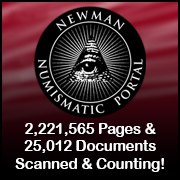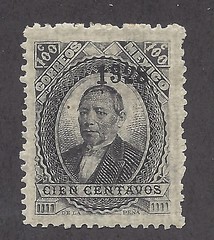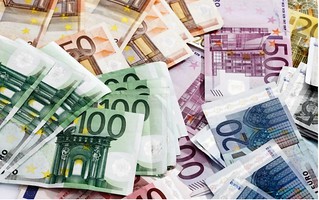
About UsThe Numismatic Bibliomania Society is a non-profit association devoted to the study and enjoyment of numismatic literature. For more information please see our web site at coinbooks.org SubscriptionsThose wishing to become new E-Sylum subscribers (or wishing to Unsubscribe) can go to the following web page link MembershipThere is a membership application available on the web site Membership Application To join, print the application and return it with your check to the address printed on the application. Print/Digital membership is $40 to addresses in the U.S., and $60 elsewhere. A digital-only membership is available for $25. For those without web access, write to: Terry White, Treasurer AsylumFor Asylum mailing address changes and other membership questions, contact Terry at this email address: terrywhite5475@yahoo.com SubmissionsTo submit items for publication in The E-Sylum, write to the Editor at this address: whomren@gmail.com BUY THE BOOK BEFORE THE COINSale Calendar |
- WAYNE'S WORDS: THE E-SYLUM DECEMBER 16, 2018
- KOLBE & FANNING NEW WEBSITE INVENTORY
- NEW BOOK: OBJECTS OF WAR
- NEW BOOK: ORDER OF ST MICHAEL AND ST GEORGE
- CHRISTMAS COIN CARDS ON THE NEWMAN PORTAL
- PROVENANCE AND PHILATELY
- MIDDLEBURY COLLEGE ANCIENT COIN APP
- NOTES FROM E-SYLUM READERS: DECEMBER 16, 2018
- MYSTERY OBJECT: ANCIENT ROMAN NIPPLE COVER?
- VOCABULARY TERMS: BEVELED BORDER AND EDGE
- SETH H. CHADBOURNE (1836-1904)
- EXHIBIT: PROOF MORGAN DOLLARS AT 2019 FUN SHOW
- STACKING THE 1907 HIGH RELIEF DOUBLE EAGLES
- NGC NOW CERTIFIES DIES
- SELECTIONS FROM THE WEINBERG COLLECTION, PART 1
- SELECTIONS FROM THE ROBINSON JANUARY 2018 SALE
- MEDIEVAL COPPER COINS FOUND AT DELHI MOSQUE
- SILVER TWO ANNA COINS STILL POPULAR IN INDIA
- KENYA ISSUES NEW CIRCULATING COINS
- THE GREAT BELZONI
- FEYNMAN'S NOBEL PRIZE MEDAL BRINGS $975,000
- PRESENTATION MEDAL AUCTION RAISES $2,420
- NIGERIAN BANKNOTE COLLECTOR ADETUNJI OMOTOLA
- FLUTTERING BANKNOTES SHUT DOWN GERMAN ROAD
- UKRAINE MENORAH MADE WITH COINS
- THE CHRISTMAS STORY ON NOTGELD
Click here to access the complete archive
Click here to unsubscribe (scroll down)
To comment or submit articles, reply to whomren@gmail.com
Content presented in The E-Sylum is not necessarily researched or independently fact-checked, and views expressed do not necessarily represent those of the Numismatic Bibliomania Society.
WAYNE'S WORDS: THE E-SYLUM DECEMBER 16, 2018
 New subscribers this week include: James Evans. Welcome aboard! We now have 5,816 subscribers.
New subscribers this week include: James Evans. Welcome aboard! We now have 5,816 subscribers.
Thank you for reading The E-Sylum. If you enjoy it, please send me the email addresses of friends you think may enjoy it as well and I'll send them a subscription (but let me know if they are located in the European Union). Contact me at whomren@gmail.com anytime regarding your subscription, or questions, comments or suggestions about our content.
I'm travelling with my family this week and much of next week and have a backlog of articles and email I'm slowly working through. If you've written and haven't heard from me, check in next week for status. Happy holidays, everyone.
This week we open with an update from numismatic booksellers Kolbe & Fanning, two new books, and Christmas coin cards on the Newman Portal.
Other topics this week include beveled borders and edges, slabbed coin dies, stacks of high-relief double eagles, the Alan Weinberg collection, Kenya's new circulating coins, a menorah made of coins, and the Christmas story on notgeld.
To learn more about the Most Distinguished Order of St Michael and St George, William A. Pettit, Seth Chadbourne, proof Morgan dollars, the Judd-1 silver center cent, the Great Belzoni and Feynman's Nobel prize medal, read on. Have a great week, everyone!
Wayne Homren
Editor, The E-Sylum
KOLBE & FANNING NEW WEBSITE INVENTORY
Kolbe & Fanning's numismatic literature listings have been updated just in time for last-minute holiday shopping. Have a look! Here's the announcement. -Editor
Kolbe & Fanning have been updating their website inventory of new publications in recent weeks and have added a number of recent titles to their existing retail stock of over 1000 books available for immediate purchase. Some newer titles include:
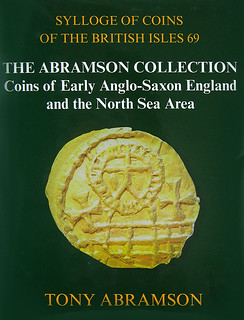
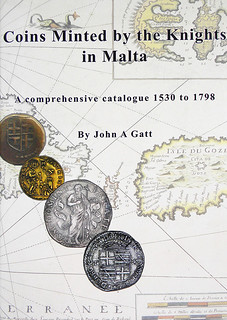
Sylloge of Coins of the British Isles, Vol. 69: The Abramson Collection, Coins of Early Anglo-Saxon England and the North Sea Area. By Tony Abramson. $75
Coins Minted by the Knights in Malta. By John A. Gatt. $220
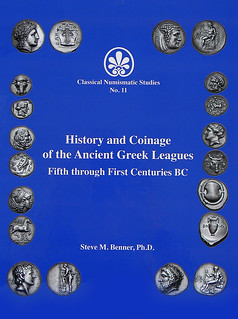
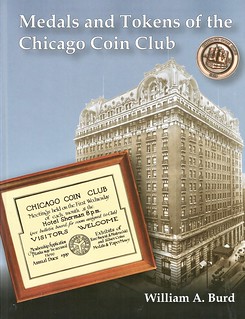
History and Coinage of the Ancient Greek Leagues, Fifth through First Centuries BC. By Steve M. Benner. $75
Medals and Tokens of the Chicago Coin Club. By William A. Burd. $45
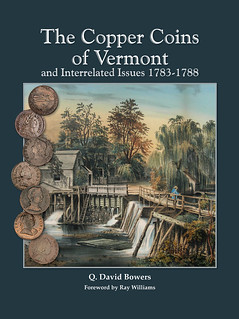
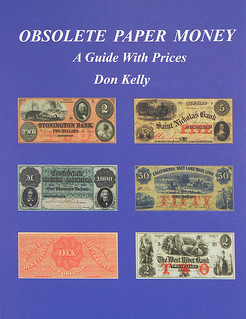
The Copper Coins of Vermont and Interrelated Issues, 1783-1788. By Q. David Bowers. $38
Obsolete Paper Money: A Guide with Prices. By Don C. Kelly. $75
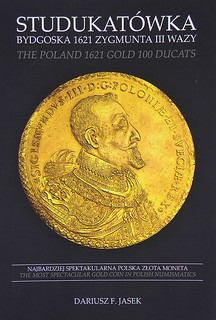
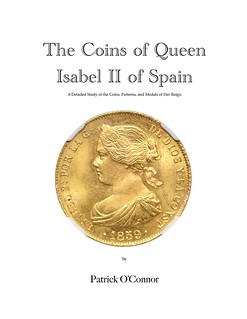
The Poland 1621 Gold 100 Ducats / Studukatówka Bydgoska 1621 Zygmunta III Wazy. By Dariusz F. Jasek. $30
The Coins of Queen Isabel II of Spain: A Detailed Study of the Coins, Patterns, and Medals of Her Reign. By Patrick O’Connor. $120
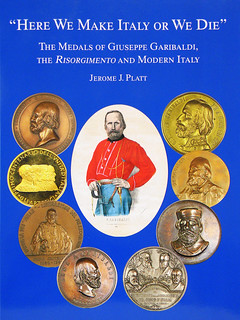
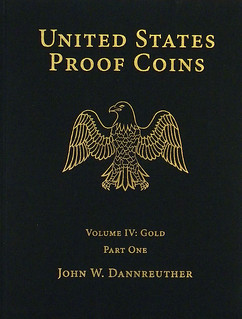
“Here We Make Italy or We Die”: The Medals of Giuseppe Garibaldi, the Risorgimento and Modern Italy. By Jerome J. Platt. $50
United States Proof Coins. Volume IV: Gold. By John W. Dannreuther. $250
Kolbe & Fanning’s website at numislit.com is always being added to, so be sure to take look and see what we have to offer!
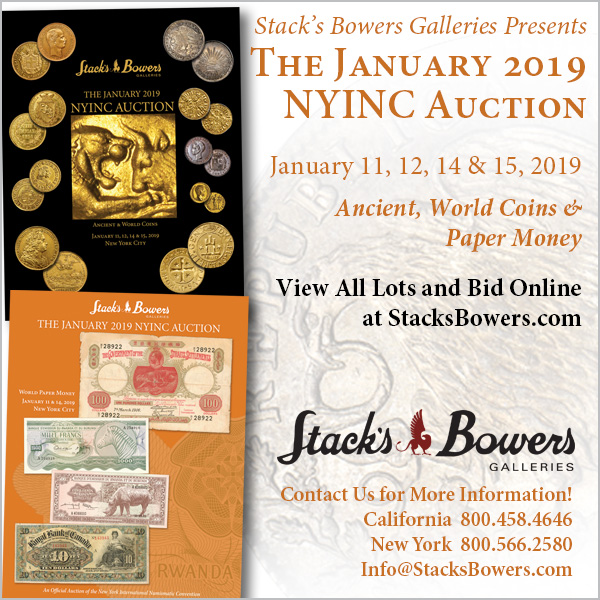
NEW BOOK: OBJECTS OF WAR
SPINK has published a new book by Kevin Clancy on currency during wartime. -Editor
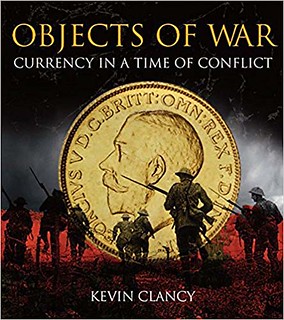 Objects of War: Currency in a Time of Conflict
Objects of War: Currency in a Time of Conflict
by Kevin Clancy
Published in association with the Royal Mint Museum
Softcover, colour illustrations throughout
136 pages
ISBN: 978-1-907427-90-9
War has shaped currencies, creating, abolishing and moulding them. By providing the means through which they have been fought, coins and banknotes have proved themselves an indispensable weapon of war. But the disruption that comes with conflict has seen usage of money change to cope with extreme circumstances. Coins have frequently been debased or often buried in hoards as an army advances, they have found themselves saving lives on a battlefield or becoming objects of sentiment as a memory of home. As symbols of state, money has offered the means through which victorious leaders have proclaimed their triumphs, evidenced from Roman Emperors through to the more poignant modern ways in which commemoration predominates.
In this new book Kevin Clancy, Director of the Royal Mint Museum, seeks to explore these themes, revealing how something which thrives on stability can adapt when the normal rules of life are turned upside down. Richly illustrated throughout, the book focuses principally on the experience in Britain from Tudor times but draws on other instances from around the world and across time to show how money and war have collided and influenced one another.
It is a fascinating story that will be as engaging to those with an interest in military history as much as to those of us with more than a passing interest in money.
For more information, or to order, see:
Objects of War: Currency in a Time of Conflict by Kevin Clancy
(https://spinkbooks.com/index.php?route=product/product&path=59/&product_id=606)
NOTE: Charles Davis is the distributor of SPINK titles in the U.S. For information on pricing and availability, contact Charlie at numislit@aol.com. - -Editor
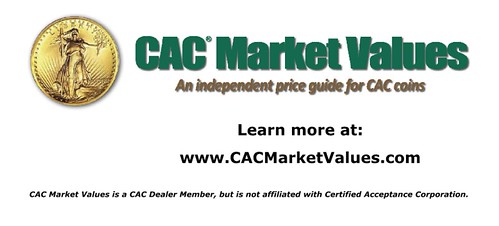
NEW BOOK: ORDER OF ST MICHAEL AND ST GEORGE
SPINK has also published a new book on one of the one of the lesser-known British medals, the Order of St Michael and St George.
Charles Davis is the distributor of SPINK titles in the U.S. For information on pricing and availability, contact Charlie at numislit@aol.com. -Editor
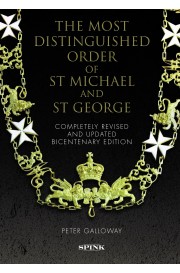 The Most Distinguished Order of St Michael and St George by Peter Galloway
The Most Distinguished Order of St Michael and St George by Peter Galloway
Completely revised and updated bicentenary edition
ISBN: 978-1-912667-00-0
December 2018
Hardback, jacketed
297 x 210mm, 704pp
In 2018, the Most Distinguished Order of St Michael and St George celebrated the 200th anniversary of its foundation. Originally instituted to recognise service in the Mediterranean region, principally in Malta and the Ionian Islands, the scope of the Order has been extended on a number of occasions, and is now the main United Kingdom honour for service overseas to British interests.
The first full-length history of the Order was published in 2000, and this newly revised and updated edition is published to commemorate the bicentenary of the Order’s foundation. Fifteen chapters cover its historical development, from it use in Britain’s Mediterranean empire, its extension to the wider British Empire, its uses by the Diplomatic Service and the armed forces in, and now for overseas service generally.
The book includes a chapter on the work of Bishop Henry Montgomery (father of Field Marshal Montgomery) in creating a chapel for the Order in St Paul’s Cathedral in 1904, and another on the changing styles of the robes and insignia.
The Order of St Michael and St George is one of the lesser-known British honours, but this well-illustrated volume helps to shed a light on the Order and tells its fascinating story.
To read the complete article, see:
The Most Distinguished Order of St Michael and St George by Peter Galloway
(https://spinkbooks.com/index.php?route=product/product&path=59&product_id=616)
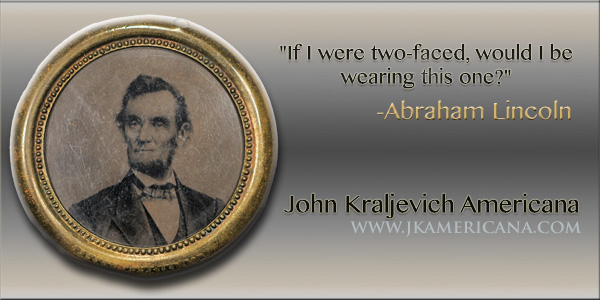
CHRISTMAS COIN CARDS ON THE NEWMAN PORTAL
Newman Numismatic Portal Project Coordinator Len Augsburger provided the following report on Christmans coin card on NNP. Thanks. -Editor
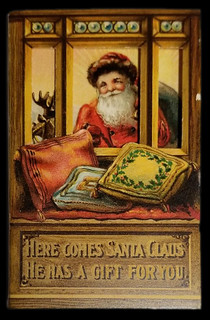
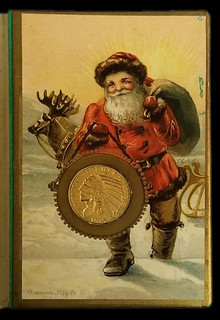
Giving the gift of a gold coin is an old holiday tradition, and today a variety of gift cards that survive from the turn of the 20th century serve to remind us of this delightful practice. The Eclectic Numismatic Treasure collection, a world-class grouping of primarily American numismatic exonumia, contains several examples of these vintage holiday cards. As a coin by itself is somewhat plain, the addition of a card personalized the gift and made for a more artistic presentation. Some of these cards were additionally inscribed by the presenter, creating even more of a personal connection. One such example illustrates Santa bearing a 1915 U.S. $5 Indian gold piece, while another is strictly promotional on the part of the Lansing (MI) State Savings Bank, reminding the receiver where the coin might be deposited. Of course, who would mind a bit of a “commercial” upon the occasion of finding a $20 gold piece in their Christmas stocking? Newman Portal acknowledges the Eclectic Numismatic Treasure collector for sharing these images, and Lianna Spurrier for image editing.
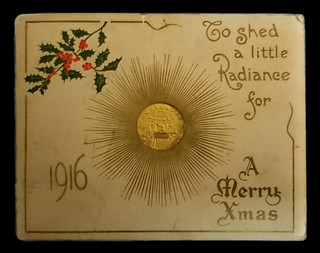

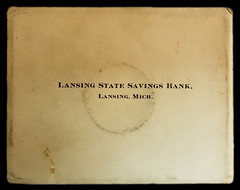
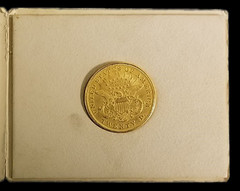
Link to Eclectic Numismatic Treasure Christmas card collection on Newman Portal:
https://nnp.wustl.edu/library/imagecollection/511173
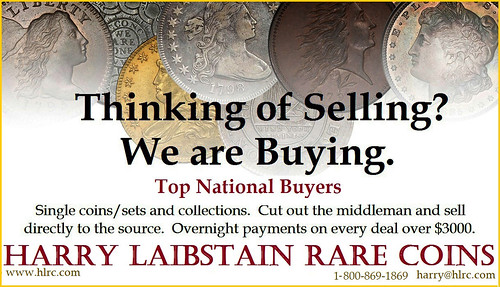
PROVENANCE AND PHILATELY
In the simplest term, provenance means the earliest known history of something. In more modern usage it refers to the record of ownership of an object of art or antique as a guide to authenticity or quality. Since the 1950’s’ when marketing became a recognized business discipline, provenance has evolved into one of the most powerful marketing tools on the planet. The very term provides a cachet or stature to items with a value that is hard to define. It accounts for why investors will pay tens of millions of dollars for an artwork that most of us wouldn’t give a second thought to if offered to us for $20 at a flea market. In fact, finding such an item at a flea market becomes a part of its provenance because it makes such a good story. Philately is full of such stories.
Provenance’s importance in philately has not been lost on the likes of auction houses. For high priced stamps they spend many hours and thousands of dollars putting together a history of rarities and then publishing book like catalogs, all in an effort to get two or more deep pocket buyers who feel a need to own the stamp into the auction room. The bidding then becomes a matter of ego rather than value, which is one reason buyers want to remain anonymous. More important is the fact that once a huge value for an item is established at a sale, that becomes a part of its provenance. If that buyer also has a recognized name, their ownership also becomes part of its legend.
As you may surmise, provenance is part facts and part marketing. The very use of the word in describing a stamp immediately separates it from the mundane. It says, here’s something you can treasure for its rarity and because it has a story you can repeat to friends or in an exhibit. This brings me to the important question of how can a dealer or collector create provenance.
The practice of developing provenance for a philatelic item may sound shady, it is anything but. When dealing with art, antiquities or stamps one needs talking points to close the sale at the best possible price. A factual provenance creates immediate value, but also, a value that carries forward and can actually grow with time. The history of the inverted Jenny stamps is a prime example where the story continues to grow over time as various copies take on a unique history, but add to the legend. This has grown to the point that the U.S. post office exploits it by printing a new series of high value inverted Jennies and markets them by mixing in some upright sheets to create a treasure hunt. Talk about exploiting provenance!
To read the complete article, see:
Provenance and Philately
(https://www.forbes.com/sites/richardlehmann/2017/03/02/provenance-and-philately/amp/)
MIDDLEBURY COLLEGE ANCIENT COIN APP
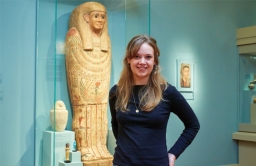
MIDDLEBURY, Vt. – A physics major from Putney, Vt., who is interning this year at the Middlebury College Museum of Art, has created an iPad interface to help showcase 30 ancient Greek and Roman coins from the College’s collection.
Louise “Roo” Weed ’18.5, the current holder of the Reiff Internship in Ancient Art, taught herself the programming language Swift in order to create a digital catalog that shows both sides of the coins, the approximate year in which they were struck, and their metallic composition and historical significance. For example, the “Posthumous Denarius of Julius Caesar” is a silver coin from 44 BCE showing the wreathed head of Caesar with the Sidus Iulium (Julian Star) on the front of the coin, and the goddess Venus with the legend “SEPVLLIVS MACER” on the reverse.
The senior will give an illustrated lecture about her work with the coins on January 24 at 6:30 p.m. in Room 125 of the Mahaney Arts Center. Weed’s public lecture will be titled “Show Me the Money: A Digital Interface for Displaying Ancient Coins in a Museum Gallery.”
The rare coins, along with an iPad containing the digital catalog, will go on permanent display in the museum’s antiquities gallery in the near future, possibly as soon as the summer of 2019.
“Coins are actually very difficult to display,” explains Professor Pieter Broucke, the museum’s curator of ancient art and Weed’s internship advisor, “because a coin is a rather small item and the label text, by the time you have explained the object, is always going to be much bigger than the coin itself. So in terms of real estate, coins are difficult to display. Also, you can only show one side of a coin. This is where the digital can really help.”
The museum plans to display 15 Greek coins on a map of ancient Greece and 15 Roman coins on a timeline, with an iPad mounted close by.
Weed’s appointment as the Reiff Intern might have seemed unlikely a few years ago. She was well on her way to majoring in physics when she enrolled in a Middlebury art history class to meet a distribution requirement. “I said, ‘Okay, whatever, I’ll just do it,’ and I took an art history class in my fourth semester here. And it turned out that I loved it, and I am really interested in Indian painting and Asian art in general. So now I am a physics major with an art history minor who is doing my senior project in a type of chemical composition analysis called Raman spectroscopy.”
After working with the coins and appreciating them as tiny works of art, Weed says, “The digital interface will eventually be available online as well as in the gallery, which will make it a valuable resource for researchers around the world. It is very important to tell the story of these coins in such a way that others from outside of Middlebury can benefit from them.” (Two previous museum interns, Shanyue “Shane” Zhong ’17 and Simone Edgar Holmes ’20, contributed extensive research to the project.)
Weed will complete her academic requirements after the 2019 winter term, after which she plans to travel in South America and work in the Putney area before deciding whether to go to graduate school and what to study there.
While enrolled at Middlebury, Weed completed an internship in astrophysics at Wesleyan University’s Van Vleck Observatory and a second internship one summer later in electrical engineering at NASA’s Goddard Space Flight Center.
Now the 22-year-old is pondering ways to combine her interests in science and art history. “Perhaps I will find some shorter-term internships to help me figure that out,” she says. “Middlebury has helped me discover passions I never knew that I had, and I feel grateful and privileged to have had that experience here.”
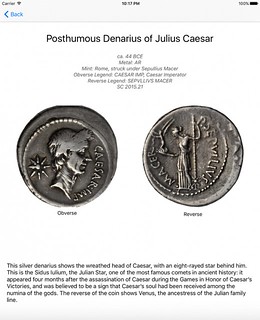

To read the complete article, see:
Show Me the Money: Student Brings Ancient Coins to Light at College Museum
(http://www.middlebury.edu/newsroom/archive/2018-news/node/605664)
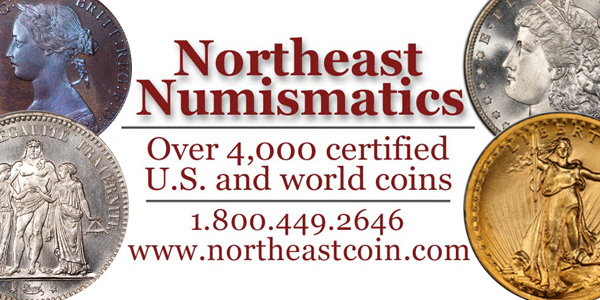
NOTES FROM E-SYLUM READERS: DECEMBER 16, 2018
On Richard Margolis
David Alexander writes:
I read with profound sorrow of the passing of Richard Margolis. I knew him reasonably well, going back to my years with Coin World and the lamented World Coins Magazine. I admired the rigor with which he policed the early New York International shows, defying dealers who attempted to display U.S. coins in that pioneer all-world show.
Here's one I dare anyone else to match: my bride Pat (nee LaBranche) and I had our honeymoon at the New York International show in December 1977 at the Americana Hotel! We had a luxurious room on the 32nd floor, to which we had rushed back for a quick change, my bride going ahead to the charter bus carrying invitees to a special showing of the Royal Mint's new facility in New Jersey, created by ex-Amos Press functionary John Van Emden. I followed just AFTER all the elevators failed! I rushed down 32 stories on foot and found there was a bar aboard! Next day was somewhat painful... The International was never the same in the ghastly environment of the Waldorf.
Bill Rosenblum forwarded this CoinsWeekly article about Margolis. Thanks. -Editor
To read the complete article, see:
Richard Margolis (1931-2018) (https://www.coinsweekly.com/en/page/4?&id=5777)
To read the earlier E-Sylum articles, see:
RICHARD MARGOLIS (1931-2018) (https://www.coinbooks.org/v21/esylum_v21n48a06.html)
READERS REMEMBER RICHARD MARGOLIS (https://www.coinbooks.org/v21/esylum_v21n49a10.html)
World Coin Comments
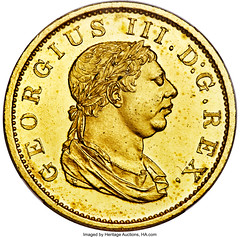
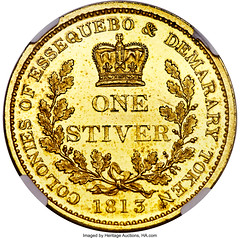
Regarding lots in the upcoming January 2018 NYINC Heritage World Coins sale, Chip Howell writes:
I'd never heard of "Essequibo & Demerary" either until earlier this year, when I stumbled onto an old ha'penny from there (alas w/a hole in it) at a coin show in Timonium, MD. As you may know now, this was incorporated into British Guiana => Guyana. I was familiar with "Demerara Sugar" which is what brown sugar is called in the UK, named for the Guyanan region.
BTW, that rhinoceros on the Gabon token looks a lot like an Asian rhino (i.e., the skin-folding "plate armor" look), but it does have the proper two horns of an African rhino, at least--like the engraver was looking at a composite drawing of a generic rhino, rather than sketching from life, which wouldn't be all that surprising, I suppose.
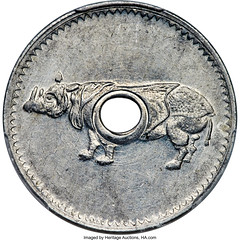
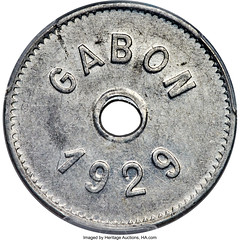
I'm not familiar with "Demerara Sugar". Interesting connection. And yeah, that rhino looks a bit odd. Thanks. -Editor
To read the earlier E-Sylum article, see:
HERITAGE 2018 NYINC WORLD COINS SALE SELECTIONS (https://www.coinbooks.org/v21/esylum_v21n49a16.html)
Query: William A. Pettit
Bill Seldon writes:
I just purchased a bound set of Whitman Numismatic Journals 1964 - 1968. Looks like they were bound for William A. Pettit. I gather he was pretty well known in the numismatic field, but I can't really find out much about him on Google.
Any chance you or some of your E-Sylum subscribers can pass on any more info. about the gentleman?
Google's fine, but a Newman Numismatic Portal search is more narrowly targeted on numismatic sources. An NNP search found 142 hits. Many of these are just mentions of his name as a club officer or meeting attendee, but the July 1995 issue of The Numismatist has an obituary of him on p111. That content is restricted, but if you're an ANA member you can read it on their web archive.
There is also an obit in the June 19, 1995 Coin World (also under copyright and restricted in NNP). But from the snippet view in search results I learned that Pettit was born Lansing, MI in 1928. He began his numismatic career in the Coin Department at Marshall Field's Store for Men in Chicago in 1956 two years after his graduation from Manchester College in Indiana. A February 28, 2016 E-Sylum piece references an April 1968 issue of The Centinel with an article by Pettit on the first struck Columbian half dollar.
So, readers - how many of you knew or met William Pettit? What can you tell us? Thanks. -Editor
To see my NNP search results for "William A. Pettit", see:
https://nnp.wustl.edu/library/searchwithterms?searchterm=William%20A.%20Pettit
To read the earlier E-Sylum article, see:
THE RESURRECTION OF THE FIRST COLUMBIAN HALF DOLLAR (https://www.coinbooks.org/esylum_v19n09a21.html)
On Recovering Coins From Junked Vehicles
Paul Schultz writes:
I saw in the last E-Sylum that coins are being recovered from junk cars. This is not new or different. Back in the late 1990s I worked at Alcoa on a project to sort out fragments of different scrapped aluminum alloys for recycling. As an example, there is much greater value to having the aluminum-copper alloys sorted and separated from aluminum-magnesium alloys than by keeping all aluminum alloys mixed together. As part of the project, I went to a company in Michigan where they shredded and recycled old cars. The company sorted steel fragments from aluminum from copper from "fluff" (seat cushions etc). and sold the metals for melting and re-use. I was supposed to look into further sorting aluminum castings (high silicon) from wrought aluminum (low silicon).
While there, I was amazed to learn that they regarded old coins left in the cars as part of their revenue stream. I forgot the exact number, but they told me that something between $1 and $5 in change was left (hidden, lost, or neglected) in the average car. After shredding the cars, they had sorting equipment that would take the now-mangled coins and keep them separate. After accumulating several thousand dollars worth of abused coins, they turned them in through government channels and got a nice check. Therefore, the story is more than plausible, the recovery of coins from scrapped cars is real, has been around for over 20 years in the US, and more coins than I imagined possible are left in junk cars.
Thanks! -Editor
To read the earlier E-Sylum article, see:
MAN CLEARED OVER IMPORTING SCRAP EUROS (https://www.coinbooks.org/v21/esylum_v21n49a20.html)
Groom Clarifies Cameron House Theory
Bill Groom writes:
I much appreciated JP Koning's commentary about redenominated coinage. I found his commentary about the Mitchell-Innes theory enlightening. That said, I'd like to correct one statement. He wrote: "The Cameron House theory, which also happens to be Mitchell-Innes's theory ..."
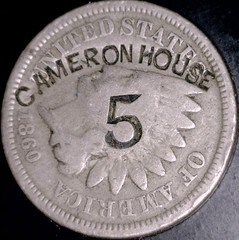 My theory wasn't about the apparent redenomination. It referred specifically to the location. Since this specific redenomination of coins appears to have been a
Civil War generated phenomenon, it's much more likely that the Cameron House counterstamps were not products of the LaCrosse establishment (as thought by some), built about
twenty years later. My theory then is that the Harrisburg Cameron House is a far more likely candidate. Harrisburg is not a slam-dunk attribution, as yet, just a stronger
contender.
My theory wasn't about the apparent redenomination. It referred specifically to the location. Since this specific redenomination of coins appears to have been a
Civil War generated phenomenon, it's much more likely that the Cameron House counterstamps were not products of the LaCrosse establishment (as thought by some), built about
twenty years later. My theory then is that the Harrisburg Cameron House is a far more likely candidate. Harrisburg is not a slam-dunk attribution, as yet, just a stronger
contender.
To read the earlier E-Sylum article, see:
THE CAMERON HOUSE THEORY (https://www.coinbooks.org/v21/esylum_v21n49a22.html)

MYSTERY OBJECT: ANCIENT ROMAN NIPPLE COVER?

Regarding last week's gold mystery object, Scott Semans writes:
If it weighs in the range of .06 to .13 grams, it may be what I call a "Gold Sombrero," though your piece appears to have been smashed flat. As far as I know these are not published anywhere, and I collect pre-colonial coinages of Malaysia and Indonesia for just this reason. For the last ten years or so construction and dredging in Sumatra has provided quantities of previously rare, obscure, or totally unknown coinages.
These and other early gold of the region reportedly come from the Musi River area of southern Sumatra, Indonesia, once the Sultanate of Palambang. Sellers there call them 1/32 Massa coins of the Kingdom of Srivijaya. Later coinages of the region, mostly tin coins imitating Chinese cash, and later tin with Javanese or crude Arabic inscriptions, have been the subject of articles by Drs. Michael Mitchiner and T. D. Yih in the Journal of the Oriental Numismatic Society, various issues 2012-13, and some other previously unknown coinages of the Srivijaya era are published in Ronachai Krisadaolarn's two recent books on Thai coinages - but not these. They are probably rare, but because nobody knows about them, they can be had for not much more than the price of a common Indian gold fannam. I'm guessing that their three dimensional shape is to make them easier to pick up.
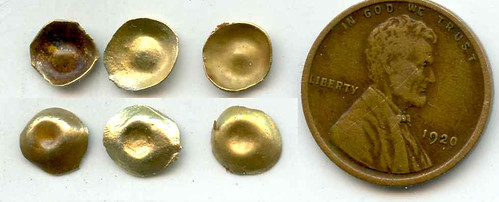
Image courtesy Scott Semans
Dave Ellison writes:
As for the Gold Mystery Object in last week's E-Sylum: Looks like an ancient Roman gold nipple cover to me!
Well, that's what's speculated in the Forbes magazine article I found this in. But no one seems to really know. -Editor
This thin gold circle with a raised middle looks very much like a nipple, and since we know the Romans were sexually quite liberal, it makes sense that perhaps it was worn by a wealthy courtesan.
Unfortunately, there is zero evidence for this mental image of bedazzled babes. Classical archaeologist Sarah Levin-Richardson says that "there is no visual evidence from Pompeii of prostitutes wearing nipple covers -- gilded or otherwise." And classicist David Meadows cautions that "considering the social status of sex workers in the ancient Roman world, I doubt they'd be trusted with gold nipples. Their clients wouldn't be trustworthy either." And at just 21mm in diameter, this object seems quite small.
To read the complete article, see: Is This Really An Ancient Roman Nipple Cover? Archaeologists Are Unsure (https://www.forbes.com/sites/kristinakillgrove/2018/12/07/is-this-really-an-ancient-roman-nipple-cover-archaeologists-are-unsure/#7ca209de1d1c)
To read the earlier E-Sylum article, see:
NUMISMATIC NUGGETS: DECEMBER 9, 2018 : Gold Mystery Object
(https://www.coinbooks.org/v21/esylum_v21n49a17.html)
VOCABULARY TERMS: BEVELED BORDER AND EDGE
Dick Johnson submitted these entries from his Encyclopedia of Coin and Medal Terminology. Thanks. -Editor
Bevel The angle of the slope between two surfaces, as the two sides of a medallic item, forming the edge; or the angle of the riser, the side of relief or lettering from the background to the top of relief. The bevel of relief, which allows a piece to be diestruck or cast in a mold, is also called draft or taper. Except for very low relief (stiacciato) all other relief must rise from its background (table). The angle of relief on the sides of this design is critical, and this is true for both devices as well as lettering. This angle must be such in the model that dies can be cut or engraved with this design, that pieces can be struck with the design, that the die can withdraw from the struck piece, and the struck piece can be ejected.
For certain cast procedures – like electroform casting – it is also necessary for the pattern to have a minimum bevel so the cast can be easily removed from the mold.
All this implies that there can be no undercuts and no nearly perpendicular relief. Obviously undercuts and too steep of relief should not be made in the model or pattern thus none will therefore exist in the galvano, hub, die or mold, or in the final struck or cast piece.
For technical reasons this minimum angle requirement is different for different die making procedures. The minimum bevel or taper required for handcut dies is 5°; for galvano casting the minimum bevel is 10°; for dies cut on a die-engraving pantograph the minimum draft or taper permitted is 15°.
The necessary reason for the higher minimum for the pantograph is that the stylus cannot trace steep relief and the cutting point cannot cut such relief (see pantograph). For this reason handcut dies, or dies made from puncheons, can have a steeper pitched relief – particularly for lettering – than dies made from oversize models that are reduced on a die-engraving pantograph. Such steep relief, however, does increase stress in diework and is often the cause of diebreaks.
A bevel of only 21/2° – called a holding taper – is such that no piece can be released from the die, it freezes on the die once it is struck. Therefore no coining or striking dies can have a relief with less than 21/2° draft. In effect any draft of less than 21/2° is the same as an undercut – impossible to reproduce in diestruck work. Perpendicular relief is called standing taper. See undercut, undercutting.
Beveled Border A medal with a border on an incline plane (instead of one flat and parallel to the field). Such incline borders most often contain lettering or ornamentation. An example is the General Motors International Craftsman's Guild Medal. See border.
Beveled Edge A medal designed with a slanting edge, requiring one side's diameter greater than the other. When two bevels are used resulting in a pointed edge, this is known as double beveled edge, and an example is the Studebaker Centennial Medal, 1952. Compare beveled border.
Looking for the meaning of a numismatic word, or the description of a term? Try the Newman Numismatic Portal's Numismatic Dictionary at: https://nnp.wustl.edu/library/dictionary
Or if you would like a printed copy of the complete Encyclopedia, it is available. There are 1,854 terms, on 678 pages, in The Encyclopedia of Coin and Medal Technology. Even running two a week would require more than 19 years to publish them all. If you would like an advance draft of this vital reference work it may be obtained from the author for your check of $50 sent postpaid. Dick Johnson, 139 Thompson Drive, Torrington, CT 06790.

SETH H. CHADBOURNE (1836-1904)
He was born the son of Seth Chadbourne, a blacksmith, and Lucinda Merrill Chadbourne on December 11, 1836 at Boston. On June 13, 1861 he married Annie Gurley Bradford (b. 1840), daughter of Rufus and Ann Bradford of Kingston, Massachusetts.
He lived in various boarding houses. He worked as a bookkeeper for Draper & Morse, auctioneers. He built a collection of American gold coins sold at auction on July 12, 1865 at the auction house of David F. McGilvray, Boston, Massachusetts. He was the recording Secretary of the New England Numismatic and Archaeological Society. He sold his coin collection of 223 + 99 lots through G. W. Beckford & Co., on December 14, 1864.
Emmanuel Joseph Attinelli writes this about him in Numisgraphics :
"Mr. Seth H. Chadbourne was born on the 11th of December, 1836, in the City of Boston, where he still resides. He is a bookkeeper by profession and has been engaged in that capacity with several of the auction-houses in the above named city. A numismatist from inclination, he commenced some twenty years ago the formation, in a modest way, of a cabinet of coins, devoting himself principally to the American series.
Although he has at times disposed of portions of his collection, he still holds on to quite an extensive cabinet of his favorite “Politicals " and “Tradesmen’s Tokens." He has long been one of the most active members of the N. E. Numismatic and Archaeological Society."
About 1890 he became an antique dealer and bookseller in the Roxbury district of Boston running the classic type of a Curio Shop.
He died on Thursday, October 13, 1904 at City Hospital of heart disease. He was survived by his wife Ann. His services were held at the Forest Hills crematory on Sunday afternoon at 2:30 p.m.
To read the complete article, see:
CHADBOURNE, SETH H.
(https://sites.google.com/a/numismaticmall.com/www/numismaticmall-com/chadbourne-seth-h)
The entire inventory of the Lupia Numismatic Library is for sale. Individual items will be available before the remaining archives are broken up into parcels sold at philatelic auctions in the U. S. and Hong Kong. Check NumismaticMall.com frequently as dozens of new items with estimates will be posted daily until everything is sold.
All inquiries will be given prompt and courteous attention. Write to: john@numismaticmall.com .

EXHIBIT: PROOF MORGAN DOLLARS AT 2019 FUN SHOW
We don't ordinarily discuss grading, but these gorgeous coin images caught my eye. Here's the press release for an exhibit of Proof Morgan dollars at the upcoming FUN show. -Editor

1901 Morgan PCGS PR 68CAM
The finest proof Morgan dollars set will be displayed by The PCGS Set Registry® (www.PCGS.com/setregistry) at the 2019 Florida United Numismatists convention for the first time anywhere in public.
Known as the “Mr. Perfection 13” collection, the award-winning, 27-coin Morgan dollar basic proof set is 100 percent complete and has a rating of 69.47, according to Cosetta Robbins, Professional Coin Grading Service Set Registry Manager.
“Many of the coins in this collection are either cameo (CAM) or deep cameo (DCAM) proof, and some have amazing, colorful toning. The anonymous owner of the set wants to share the remarkable beauty of these coins with visitors to the FUN show,” said Robbins.
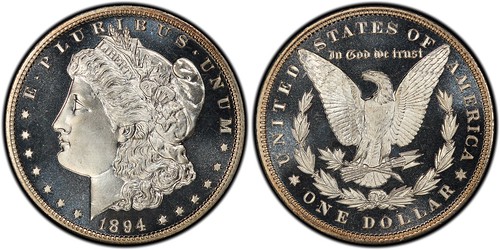
1894 Morgan PCGS PR68+DCAM
The set will be displayed at the PCGS booth, #1203, from Thursday morning to early Saturday afternoon, January 10-12, 2019, at the FUN show in the Orange County Convention Center West Building in Orlando, Florida.
Highlights of the “Mr. Perfection 13” proof Morgan dollar set include: 1880 graded PCGS PR68CAM, 1889 PCGS PR68CAM, 1894 PCGS PR68+DCAM, 1895 PCGS PR67+CAM, and 1901 PCGS PR68CAM.
The coin’s owner said, “This is one of my favorite sets.” In 2018 he upgraded three spectacular proof Morgan dollars: 1885 PCGS PR68CA, 1898 graded PCGS PR68DC and 1899 PCGS PR67+DC.

1889 Morgan PCGS PR68CAM
Information about each coin in the set is available online at https://www.pcgs.com/setregistry/dollars/morgan-dollars-major-sets/morgan-dollars-basic-set-proof-1878-1904/publishedset/109798 .

STACKING THE 1907 HIGH RELIEF DOUBLE EAGLES
Dave Wnuck's Making the Grade newsletter is always an interesting read. The December 6, 2018 issue addressed the topic of stacking the High Relief St. Gaudens double eagles. With permission we're republishing it here. Thanks. -Editor
 Every once in a while, as a dealer you come across a really cool collection that makes going through all of those piles of "stuff" (modern proof & mint sets,
modern world coins by the ton) worthwhile. This is one such collection.
Every once in a while, as a dealer you come across a really cool collection that makes going through all of those piles of "stuff" (modern proof & mint sets,
modern world coins by the ton) worthwhile. This is one such collection.
I purchased it earlier this year. As I mentioned in an online coin chat room recently, this collection is a time capsule. It was formed by a president of a small bank in New England, who was employed from the 1920's through the early 1960's. It has sat in a safety deposit box since that time.
He obviously was a bit of a collector. I suspect he had his tellers put aside any unusual coins and paper money they came across. Lots of really interesting stuff, but what might be the coolest (and certainly the items with the most monetary value) was this group of 3 high relief $20's.
It was suggested in that online forum that I should try to see if they stack, since that was mentioned as one of the reasons the mint switched to the low relief design later in 1907. Good idea -- so I did so. There are very few times in life when I am blessed with having three raw, uncirculated high reliefs on my desk at one time. Counting this instance, there has been a total of one time so far.
As you can see from the photo, they stacked just fine. No wobbling at all caused by the high relief design.
It turns out, though, that "stacking" refers to the height of a pile of coins, not to the coins "wobbling." The height of a pile of 20 double eagles was the informal standard in bank counting rooms. This piece of information was explained to all of us in that chat room by numismatic researcher extraordinaire Roger Burdette (Isn't the Internet wonderful?).
Roger actually produced a copy of a letter dated January 9, 1908 from engraver Charles Barber stating that a stack of 20 high relief coins was about the same height as a stack of 21 double eagles made in the conventional “low relief” manner. So that was the actual “stacking problem” – not the fact that the coins couldn't be successfully stacked.
So – Roger Burdette knew this already, thanks to his brilliant in-depth research using original mint documents. I didn't know it though. And I suspect many of you out there in coin-land didn't know it either.
The high relief double eagles stacked just fine. Their thickness simply “messed up” pile heights in bank counting rooms. That, and the difficulty of minting them – each coin required 3 blows from the press to bring up the details – doomed them to less than one year of production. But in that brief period they minted some of the most popular coins the US mint has ever produced.
To read the complete newsletter, see:
Making the Grade #40: A Myth
About High Relief St. Gaudens $20 Gold Finally Proven False; Plus - New Purchases
(http://www.davewcoins.com/newsletter/making-the-grade-40-a-myth-about-high-relief-st-gaudens-20-gold-finally-proven-false-plus-new-purchases)
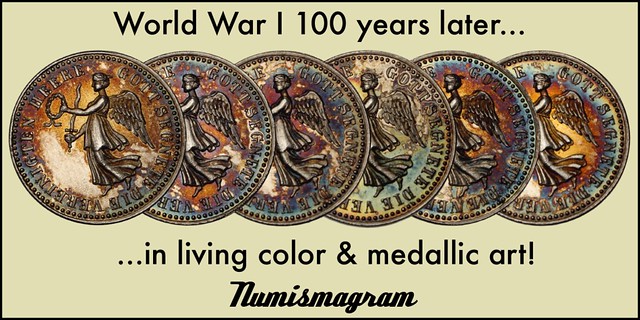
NGC NOW CERTIFIES DIES
This press release from NGC announces their new service for certifying and encapsulating coin, token and medal dies. -Editor
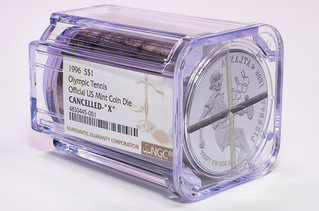
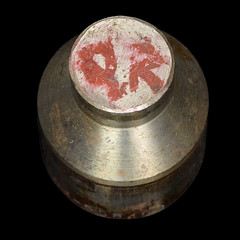
Right: Type 1. Cancelled – Defaced
Numismatic Guaranty Corporation® (NGC®) has announced a new certification and encapsulation service for coin, token and medal dies. As many numismatists know, dies are the tools used in the minting process to strike a planchet and impart the coin’s design.
After their useful life is over, dies are usually destroyed by a mint. Sometimes, however, they are cancelled and sold as a numismatic product or scrap. These cancelled dies are defaced to prevent them from being used to illegitimately strike more coins. Dies that have not been fully defaced and still show part of the coin’s design are particularly desirable to collectors.
In rare cases, a die may be inadvertently released by a mint without any defacement or cancellation. These dies, which show the coin’s full design, are highly prized by collectors. NGC divides its certification of dies into five categories:
1. Cancelled – Defaced
NGC Certification Fee: $20
Defaced dies have had their designs completely removed. While the design has been destroyed, it is usually possible to determine the denomination of the die by the diameter of the face and markings on the shaft or base. Fully defaced dies from the U.S. Mint are relatively easy to find today as many were sold to collectors in the late 1990s and early 2000s along with a coin struck by the die and a certificate of authenticity (COA). In order for NGC to attribute such a die by date and design, the die must be submitted to NGC with the US Mint’s original COA, which includes the die number (found on the die) and type of coin struck.
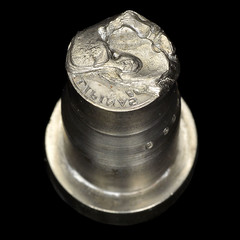

Types 2 and 3
2. Cancelled – Torched
NGC Certification Fee: $20 Fee
The majority of the face of a torched die has been melted, leaving only tiny areas of the design visible (if any). The diameter of the face of the die and/or its markings can be used to help identify the denomination it once struck. Most examples are from the San Francisco Mint in 1968 (most were proofs). After the design area was melted by a blowtorch, the dies were sold as scrap by the General Services Administration. Fortunately, many were saved.
3. Cancelled – “X”
NGC Certification Fee: $50
An “X” has been ground into the face of the die, leaving the majority of the design visible. This type of cancelled die is very popular since most of the design can still be seen. The most commonly seen examples of “X” cancelled dies are late 1990s commemorative dies, one of which is pictured...

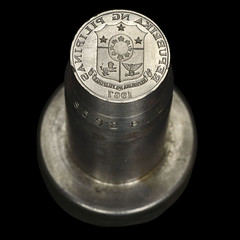
Types 4 and 5
4. Cancelled
NGC Certification Fee: $20
The generic “Cancelled” category includes all other types of cancellation used by mints. This includes partially defaced dies, such as the Mercury Dime obverse die pictured...
5. Uncancelled
NGC Certification Fee: $100
These dies have no evidence of cancellation. These are the rarest type of die, as they are seldom released. However, this 1967 Philippines 10 Sentimos Obverse Die, pictured..., is an example.
Fred Weinberg, an error coin expert and dealer in dies, sees great value in this new program. “NGC has invented a solution to market the quantity of official U.S. Mint defaced coin dies that I own,” he said. “Now, instead of just looking like a nice paperweight, the NGC encapsulation helps display all sides of the dies and includes the NGC Label with a full description of the enclosed die.”
Dies submitted to NGC for certification will be encapsulated in NGC’s clear, tube-shaped holders. Comprised of high- quality, inert materials, these holders are designed for long-term preservation and superior display. Each holder is ultrasonically welded with an internal label that features a description of the die as well as a unique NGC certification number.
NGC’s holder (which is included in the certification fees listed above) can accommodate dies that are up to 40.6mm wide and 59.6mm tall. Dies that are too large to be encapsulated can receive an NGC Photo Certificate, which features high- resolution photographs of the die along with a description and unique NGC certification number.
Dies from all countries are eligible for this new program at the same prices listed above. To submit, use a standard NGC Submission Form and write the category of cancellation in bold letters at the top of the form. Submit each category on a separate form and do not mix coins with dies on the same form. Counterfeit or altered dies will not be encapsulated and the full grading fee will apply. For dies that are of questionable authenticity or that otherwise cannot be certified, the grading fee will be refunded less a $5 handling fee.
THE BOOK BAZARRE
SELECTIONS FROM THE WEINBERG COLLECTION, PART 1
Here's a selection of lots that caught my eye in the upcoming Heritage sale of the first part of the Alan V. Weinberg collection. There will be five or six sales in all of this 60-year collecting effort, with many items having been off the market for decades. -Editor
Lot 4302: 1790 Standish Barry Threepence

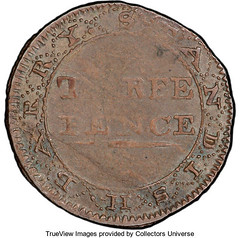
1790 Standish Barry Threepence, AU53
W-8510, Among the Finest Known
1790 3PENCE Standish Barry Threepence AU53 PCGS Secure. Breen-1019, W-8510, R.6. Ex: Seavey-Parmelee-Park-Weinberg. Die alignment: 0°. An exceptional example of this rare post-Colonial issue, of which perhaps two dozen are known. The peripheries are more firmly struck than the centers, and the strike is typically uneven. ALTIM of BALTIMORE is fairly weak, while the date -- uniquely expressed as JULY 4 90 -- is well-struck and TOWN is downright bold. The center portrait is about as clear as ever encountered on these pieces. The reverse center's THREE PENCE is weak, as almost always, but most of the peripheral legend is distinct, with some softness at the opening STA of Barry's given name. The planchet is slightly out of round, but the design elements and all legends are complete. This piece shows no evidence of the prominent die cracks visible on both sides of the magnificent MS64 example -- the finest known in private hands -- sold by us in January 2015 as part of the Donald G. Partrick collection.
Standish Barry of Baltimore was one of two Maryland silversmiths to strike silver coinage in the years between the ending of the Revolutionary War and the establishment of the Mint at Philadelphia, John Chalmers having struck several types of silver coins in Annapolis in 1783. Both coinages saw extensive circulation, judging from the condition of surviving examples. Beyond the simple need to provide a circulating medium, however, the exact motivations behind the Barry threepence are uncertain. The unusually precise date has led to speculation that it may have been issued in commemoration of a local event, possibly held in honor of the signing of the Declaration of Independence, though Independence Day as such was inconsistently and mostly unofficially observed at the time.
The obverse figure has also been the subject of much deliberation, with George Washington being the most commonly proposed identification, along with Standish Barry himself. In the Spring 2009 issue of the C4 Newsletter, however, Max B. Spiegel brought to light an 1843 article from the Baltimore Sun that named the figure depicted as James Calhoun, who was serving in a position analogous to Mayor in Baltimore on July 4, 1790. A comparison of contemporary portraits of Calhoun and the threepence's obverse figure strongly suggests that this attribution is accurate.
Alan Weinberg's Commentary: One of the most difficult to acquire American colonial coins and the only such coin specifically dated July 4, 1790. Almost all of the surviving specimens are severely worn or holed and plugged. The few remaining are on irregular, short planchets with weak strikes at the reverse center and peripheral legends cut short. The desirability of this full flan, well-struck silver coin, so similar in size to the 1792 half disme, is reflected in its distinguished pedigree. Only one or two are considered superior, Ford's the finest. One of my favorite coins, pre-dating the 1792 patterns.
Additional Commentary: This specimen was part of the extraordinary collection formed in the 19th century by Bostonian Lorin G. Parmelee. Building on an already remarkable cabinet, Parmelee developed it into one of the best ever by purchasing entire collections outright, skimming the handful of pieces needed, and selling the rest at auction. He did this with the George F. Seavey, J. Carson Brevoort, and Charles I. Bushnell collections, as well as with selections from the Sylvester S. Crosby collection. The present coin was from the Seavey cabinet, and was featured in the catalog of Parmelee's collection when it finally came to market in 1890. Listed on page 87 of the 2019 Guide Book.
Ex: George F. Seavey Collection (1873), Descriptive Catalogue listing 188; Lorin G. Parmelee Collection (New York Coin & Stamp Co., 6/1890), lot 303; Laird U. Park Collection (Stack's, 5/1976), lot 21.
Great coin with a great provenance. -Editor
To read the complete lot description, see:
1790 3PENCE Standish Barry Threepence AU53
PCGS Secure. Breen-1019, W-8510, R.6.... (https://coins.ha.com/itm/colonials/1790-3pence-standish-barry-threepence-au53-pcgs-secure-breen-1019-w-8510-r6/a/1291-4302.s)
Lot 4308: 1792 P1C Silver Center Cent
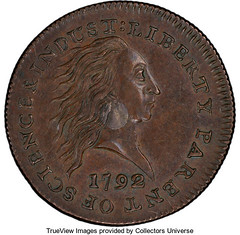

1792 Silver Center Cent, SP58+ Brown Rare, Historic Early Pattern, Judd-1 Warner-Winsor-Weinberg Specimen
1792 P1C Silver Center Cent, Judd-1, Pollock-1, Low R.7, SP58+ Brown PCGS Secure. CAC. Produced in the earliest days of the United States Mint, at a time when the monetary system of the country was just beginning to take shape, it is virtually impossible to overstate the importance of the 1792 Silver Center cent. With only 12 examples currently traced, it is among the rarest and most historically interesting issues in all of American coinage. Its distinctive bimetallic appearance is unlike any other early American coin and this piece is an especially pleasing example, with strongly impressed design elements and remarkably few abrasions. Heritage Auctions is privileged to present this iconic early pattern in just its fourth auction appearance since 1884.
The 1792 Patterns
The 1792 patterns are among the most valuable and important issues in all of American coinage. The first products of the United States Mint, these patterns represent the founding fathers' attempt to establish a useful and efficient monetary system for the new country. Based on specifications laid out in the Mint Act of 1792, the Silver Center cent, Fusible Alloy cent, Birch cent, half disme, disme, and Eagle on Globe quarter are the lineal ancestors of the coins we use in everyday life today, 226 years after their production. Although many of the designs were not ultimately adopted for regular coinage, the all-important concept of the decimal system, with the dollar as basic monetary unit, survives to the present day. The stability and durability of the U.S. monetary system can largely be attributed to the ingenuity and forward thinking embodied in these initial coinage efforts.
The Silver Center Cent
The Judd-1 Silver Center cent is arguably the most famous of the historic 1792 patterns. It was the nation's first bimetallic coin and the first documented striking of any coin within the confines of the First United States Mint. The Mint Act of 1792 specified the value of the cent as equivalent to 264 grains of copper, but it was felt that a copper coin of that size would be too unwieldy for practical use. The Silver Center cent was an effort to produce a coin with the intrinsic value of one cent in a more convenient, smaller size. The concept originated with famous patriot Thomas Paine, who outlined his thoughts on bimetallic coinage in a letter to then-Secretary of State Thomas Jefferson on September 28, 1790, a year and a half before the Mint Act was passed:
"The metal convenient for a coin under the silver coin, should not differ more in its value from silver than silver does from gold-and if it differed still less it would be better; but as the relative values now stand, the difference increases where convenience requires it should decrease. But as no such a metal, which convenience requires, exists naturally, the question is whether it will answer to produce it by composition.
The Present Coin
The coin offered here first surfaced in the Thomas Warner Collection (S.H. & H. Chapman, 6/1884). The Chapman's notes on this coin in lot 3215 of the catalog provide a good description of the design and outline the contemporary knowledge about the issue:
"1792. Cent. The Silver Centre. Head of Liberty, with flowing hair, facing r.; LIBERTY PARENT OF SCIENCE & INDUS.: 1792 under the bust. Rev. Laurel wreath, composed of two branches, tied by a ribbon, enclosing ONE CENT; outside of wreath, UNITED STATES OF AMERICA, the fraction 1/100 beneath the knot of the bow. A silver plug inserted in centre of planchet before the piece was struck, the idea being to give the value of the metal. Edge milled. Sharp, strong, even impression. Extremely fine. The finest of the five known. Of excessive rarity and a very valuable coin which should increase greatly in price before many years. The United States Mint collection does not contain one. Bushnell's sold for $120, and this is a sharper impression and lighter color. See Plate XII."
The lot realized a strong price of $155, to coin dealer George Cogan, who may have been acting as an agent for someone else, or may have purchased the coin for inventory. In any case, the Chapman brothers handled the coin again a few years later, when they cataloged the collection of prominent numismatist Richard B. Winsor in December of 1895. The coin appeared in lot 291 of that sale:
"1792 Silver Centre Cent. Bust of Liberty with flowing hair, facing right, beneath bust 1792: around, LIBERTY PARENT OF SCIENCE AND INDUST. R. Wreath of myrtle, enclosing ONE CENT; beneath bow 1/100; around UNITED STATES OF AMERICA. Borders and edge milled. Copper with silver plug inserted in the planchet before striking, so that now the silver bears its share of the impression and device - the idea being to have the value of the metal in the coin. Extremely fine. Light olive color. One of the finest examples of this excessively rare coin known. Probably not more than five exist. Cost $125. Plate. See Bushnell sale, No. 1766, sold for $120."
The lot brought another strong price of $127.50, this time to well-known dealer Édouard Frossard. Frossard died in 1899 and it is possible that he held on to this piece until his death, as the coin vanished for almost a century after its appearance in the Winsor catalog. It must have been moving outside of numismatic channels until it surfaced again in lot 233 of the Loye Lauder Collection (William Doyle Galleries, 12/1983). Loye Lauder was a mysterious figure, who shunned publicity and kept her collecting activities very low key. Rumored to be an heir to the Estee Lauder cosmetics fortune, we have not been able to establish her relationship to that famous Hungarian-born entrepreneur. Our best information indicates she was born in 1911 and died in 1964, so she must have acquired her numismatic collection before the later date. This makes her collecting life more or less contemporaneous with that of Emery May Holden Norweb. These two women both built remarkable collections at a time when female collectors of Colonial and early American coins were almost as rare as the coins themselves.
Lauder's collection was preserved intact by her estate for almost two decades after her death. Curiously, the collection was finally consigned to William Doyle Galleries, a firm that dealt mainly in antiques and had little experience with numismatic auctions. The timing of the sale was not ideal, as it took place three days after Stack's sold the remarkable Colonial collection of John Roper. Alan Weinberg had a strong interest in coins offered in both auctions. Unfortunately, he was unable to stay in New York long enough to attend both auctions himself, so he arranged for prominent dealer William Anton to represent him at the Lauder sale. Doyle Galleries conducted the sale in a manner more suited to an antiques auction than a numismatic event. In Alan's words, "Unbelievably, the format was a 'Dutch auction' - where the coin up for sale is offered at a high start price and, if no takers, keeps dropping until someone raises their arm." The 1792 Silver Center cent in lot 233 was initially offered at $70,000, the highest price Weinberg had authorized Anton to bid. Wisely, Anton refrained from bidding at that level and let the coin drop incrementally until it reached a $40,000 asking price. He judiciously placed his bid at that point, winning the lot, while other dealers looked on in astonishment. A week later, when the shock wore off, one of the dealers at the sale contacted Weinberg and offered him a $10,000 profit for the coin he won in this unorthodox fashion. Of course, he refused the offer. The coin has been a cornerstone of his remarkable collection for the intervening 35 years.
Alan Weinberg's Commentary: One of the best acquisitions I've made in over 58 years of collecting. This coin was auctioned by Doyle Galleries, a New York City antique auction house, out of the Loye Lauder Collection. The sale took place less than a week after Stack's classic John Roper auction, which I attended in December of 1983. The Roper sale included another Judd-1 with a severe quarter-inch reverse planchet lamination missing, which sold for $18,000 to Tony Terranova. I could not stay in New York another five days, so I had my good friend Bill Anton represent me at the Doyle auction. Bill did not need a Judd-1, since he already owned the "Morris" coin. Little did Bill realize that his Morris coin had a questionable silver plug.
Doyle's Lauder auction was a very peculiar "Dutch Auction" where they started the coin at $70,000 and worked their way down, with no one bidding and everyone sitting on their hands, to $40,000 before Bill raised his hand. Bam! The lot was immediately hammered closed, at half the catalog estimate. Jaws dropped throughout the auction room. A week later, I received a call from a prominent dealer who attended the auction offering me a $10,000 profit for the coin. I declined. I consider this coin the third-finest known, after the Garrett and Norweb examples. In some respects, it is even finer than the Norweb example, as that piece has a defect in the field at Liberty's forehead and a slight planchet clip at 10 o'clock that is now concealed by the holder.
A collection centerpiece! -Editor
To read the complete lot description, see:
1792 P1C Silver Center Cent, Judd-1,
Pollock-1, Low R.7, SP58+ Brown PCGS Secure. CAC.
(https://coins.ha.com/itm/large-cents/1792-p1c-silver-center-cent-judd-1-pollock-1-low-r7-sp58-brown-pcgs-secure-cac/a/1291-4308.s)
Lot 4310: 1792 Birch Cent, Plain Edge
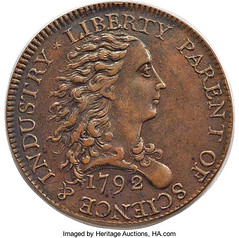
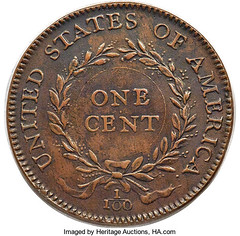
1792 Judd-3 Birch Cent Electrotype Made from the Appleton Specimen
1792 Birch Cent, Plain Edge, Judd-3, Pollock-4, AU. 224 grains, 33 mm. The Birch cent ranks among the most famous 1792 pattern coin designs and is highly popular with the few collectors who are fortunate to own an example. There are four Judd numbers of two different designs of Birch cents. Judd-3, 4, and 5 differ in edge inscription, and Judd-6 has a different reverse design. Just 14 Birch cents survive of all four varieties, and two of those are in museums. We believe that this piece was made from the Appleton specimen of Judd-3, although the authors of 1792: Birth of a Nation's Coinage write: "It is difficult to identify the host coin for many electrotypes made from [these] pieces." Both sides are slightly wavy, not unusual for these electrotypes. The surfaces are glossy chocolate-brown with traces of orange in the protected areas. A glass reveals slightly pebbly surfaces. Overall, a highly attractive example with subtle file marks masking the seam on the edge, and no evidence of lead showing anywhere.
Alan Weinberg's Commentary: From Maurice Gould's Boston estate. The finest Birch cent electrotype I've ever seen. The few others are pebbly, with uneven wavy surfaces. This is simply superb and, as I couldn't afford the genuine Birch cent, let alone the rare opportunity to acquire one, I acquired this. I was present at the Johns Hopkins / Garrett, Part IV auction wherein there was the Gem copper Birch cent and the unique white metal Birch cent from different dies. The first to Don Partrick and the second to Bill Anton at less than half the price of the copper example. Ever the clever bargainer, Bill confided in me right after the sale that he and Partrick divided up the Birch cents beforehand so as to save each other money. Obviously, Bill got way the better deal.
Ex: Maurice Gould.
Numismatic history in your hands. -Editor
To read the complete lot description, see:
1792 Birch Cent, Plain Edge, Judd-3, Pollock-4, AU. ...
(https://coins.ha.com/itm/large-cents/1792-birch-cent-plain-edge-judd-3-pollock-4-au/a/1291-4310.s)
Lot 4323: 1792-Dated CENT Circa 1859 Dickeson Restrike Token


1850s Dickeson Token, Eagle on Half Shield Design Judd-C1792-1, MS64 Red and Brown
1792-Dated CENT Circa 1859 Dickeson Restrike Token, Breen-1380, Judd-C1792-1, MS64 Red and Brown PCGS Secure. Ex: Weinberg. The proper description of the die is an Eagle Standing on a Half Shield. Nineteenth century numismatist Montroville Dickeson created this token around 1859. Upon acquiring the two dies and noticing a similarity to the 1792 Eagle-on-Globe pattern design, Dickeson concluded that these dies must have been intended for 1792 pattern coins as well. The authors of 1792: Birth of a Nation's Coinage discuss the Dickeson pieces in that reference. They include a census of examples known to them, recording just two dozen pieces. Six of those are in museums. These pieces are substantially rarer than generally believed.
The Weinberg specimen is stunning. The surfaces are prooflike with considerable mint red color and lovely blue overtones. A few old spots are evident. Overall, an impressive example of this prized piece.
Alan Weinberg's Commentary: The fascinating "1792" Dickeson patterns were apparently struck in two batches at separate times in 1859 or 1860. This is one of the few Prooflike specimens known with almost "watery" fields and considerable original color. Most often this beautiful coin is found with non-reflective, satiny, dark brown surfaces. I did feel this "pattern" was so aesthetically pleasing and attractive that it belonged in a 1792 U.S. pattern collection, as did Woodin, Pollock and the three authors of the new 1792 coinage reference.
A real beauty. -Editor
To read the complete lot description, see:
1792-Dated CENT
Circa 1859 Dickeson Restrike Token, Breen-1380, Judd-C1792-1, MS64 Red and Brown PCGS Secure....
(https://coins.ha.com/itm/patterns/1792-dated-cent-circa-1859-dickeson-restrike-token-breen-1380-judd-c1792-1-ms64-red-and-brown-pcgs-secure/a/1291-4323.s)
Lot 4318: 1793 1C Wreath, Lettered Edge

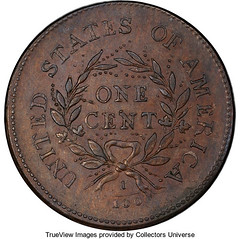
1793 S-11c, B-16c Wreath Cent, AU55+ Lettered Edge Ex: Davis-Naftzger
1793 1C Wreath, Lettered Edge, S-11c, B-16c, Low R.3, AU55+ PCGS Secure. Ex: Clarke-Naftzger-Weinberg. The mixture of die states of the two Lettered Edge types for S-11 proves that the edge devices were placed on the coins first, and then they were struck in a separate operation. All examples of the S-11a Vine and Bars edge subvariety are in the earliest die state, while S-11b and S-11c are known in all of the four die states described in the Breen Large Cent Encyclopedia.
After appearing for sale in the January 1890 New York Coin & Stamp Company sale of the R. Coulton Davis collection, this piece was off the market until super-collector Ted Naftzger included it in the New Netherlands sale of his duplicate coins in 1973. The cataloger for New York Stamp & Coin wrote:
"1793 Wreath: same dies as last, but edge inscribed ONE HUNDRED FOR A DOLLAR: sharp, clear impression, slightly chafed on highest locks of hair, well centered: light olive color: very fine and desirable."
The New Netherlands cataloger in 1973 provided more detail:
"1793. S-11c (R-3). C. 11-J. Wreath. Lettered edge, single leaf after dollar. About Uncirculated-55. Natural light olive and medium brown even color, but with a much smoother surface than the last. Struck evenly on the obv., while the rev. is struck slightly off center towards twelve o'clock. Formerly thought to be finest and closely challenged by several others, but the Brand collection produced a clear finest known Mint State-60 specimen. One of the best lettered edge cents we have seen and been privileged to sell."
Alan Weinberg's commentary: Nice light brown and one of the three or four finest specimens known. I bought this slabbed from Jim McGuigan, consigned by Denis Loring, only on condition I could break it out of its old slab first to examine the rims as I dislike rim bumps. Jim agreed so long as I would agree to pay the re-slabbing fees if I disliked the rims. Viola! The rims were immaculate. Thanks Jim!
The Weinberg Specimen. Breen Die State I, with no visible clash marks on either side. Splendid and fully natural light olive and medium brown with splashes of mahogany patina on each side. A trace of wear is evident on the highest hair locks. Bill Noyes and Del Bland each assign a conservative grade of XF45, and they agree that this piece is tied for the sixth finest S-11c Wreath cent.
Ex: Robert Coulton Davis (New York Coin & Stamp Co., 1/1890), lot 2511; S.H. & H. Chapman; later, Dr. William H. Sheldon; T. James Clarke (10/1954); R.E. Naftzger, Jr. (New Netherlands, 11/1973), lot 334; R.E. Naftzger, Jr.; Michael Elliott; Bruce Stowe (10/1995); Thomas D. Reynolds (2/1997); Denis W. Loring; via Jim McGuigan.
Fabulous coin with another excellent provenance.
The consignor comments are a nice feature. It's transparent, and adds color that a cataloger can't necessarily provide. I like it. -Editor
To read the complete lot description, see:
1793 1C Wreath, Lettered Edge, S-11c, B-16c, Low R.3,
AU55+ PCGS Secure. ... (https://coins.ha.com/itm/large-cents/1793-1c-wreath-lettered-edge-s-11c-b-16c-low-r3-au55-pcgs-secure/a/1291-4318.s)
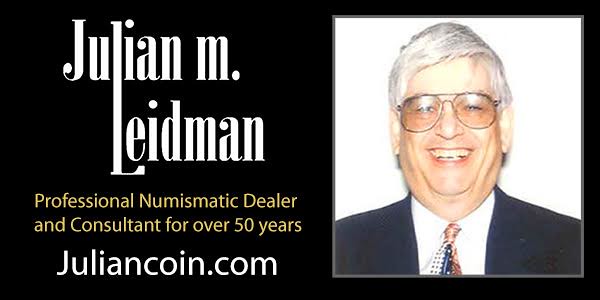
SELECTIONS FROM THE ROBINSON JANUARY 2018 SALE
Here are a few selected items Frank Robinson provided from his latest sale of ancient and early coins, closing on January 15, 2019. See the complete catalog online for full details. Some - shall we say - colorful descriptions here. -Editor
Lot 31: The Only Coin of Egypt Under the Pharaohs
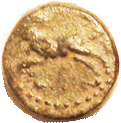

EGYPT, PHARAOH NEKTANEBO II, 361-343 BC, Æ15, Leaping ram/scales; F-VF, a little off-ctr, ram's head weak; dark greenish patina with earthen hilighting. Ex Gorny as VF.
The ONLY coin of Egypt of the Pharaohs (there's also a very rare gold version), tho some evidence suggests a Syrian issue.
(A GVF brought $4313, Triton 1/05; VF $5423, Gorny, 3/07.) MB $125
Lot 151: Coin of Thasos
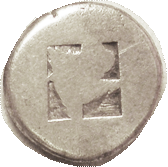

THASOS, Stater, 510-480 BC, ithyphallic reality TV satyr grabbing struggling nymph [REDACTED]; S1746 (£425); Nice strong AVF, well centered & struck, good bright metal, fine archaic style. (A VF realized $4500, Peus 10/07.) Starting Bid $235
Lot 270: FIDES EXERCITVS
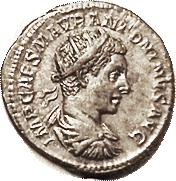
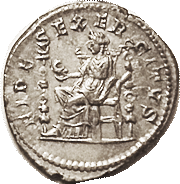
 Ant, FIDES EXERCITVS, Fides std with 2 standards; AEF, well centered, a few wk letters on rev, good metal with nice lt tone & underlying luster; strong pensive looking
portrait, belying his actually depraved character. (A VF/AEF sold for $210, Varesi 11/05.) Starting Bid $60
Ant, FIDES EXERCITVS, Fides std with 2 standards; AEF, well centered, a few wk letters on rev, good metal with nice lt tone & underlying luster; strong pensive looking
portrait, belying his actually depraved character. (A VF/AEF sold for $210, Varesi 11/05.) Starting Bid $60
To view the complete sale catalog, see: http://www.fsrcoin.com/m.html
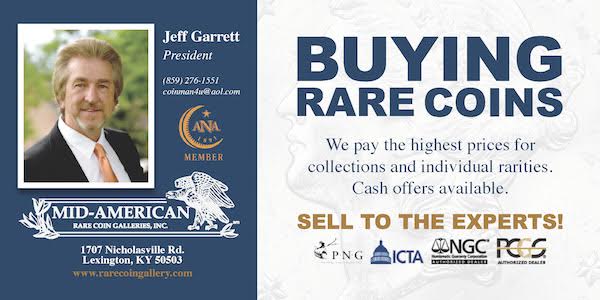
MEDIEVAL COPPER COINS FOUND AT DELHI MOSQUE
Found via The Explorator newsletter, this article from The Hindu discusses a chance find of a pot of copper coins at a mosque in Delhi. They're thick pieces - the article likens them to "biscuits." -Editor
 The mosque is fenced in by high compound walls and the uneven ground is lower than the houses that surround the structure. It is deathly quiet inside, with its myriad
archways partially lit by Delhi’s smoggy sunlight. Standing there, it is easy to imagine a priest, or a trader, furtively hurrying along the walls of the mosque to find a
spot to bury treasure.
The mosque is fenced in by high compound walls and the uneven ground is lower than the houses that surround the structure. It is deathly quiet inside, with its myriad
archways partially lit by Delhi’s smoggy sunlight. Standing there, it is easy to imagine a priest, or a trader, furtively hurrying along the walls of the mosque to find a
spot to bury treasure.
Treasure is what the Archaeological Survey of India (ASI) found two months ago in this complex — a hoard of small copper coins vaguely resembling those bite-sized Britannia biscuits from the 90s.
A team from ASI’s conservation wing was levelling the ground in early September as part of ongoing conservation work when one of the workers’ pickaxes landed on a mud pot. Work was halted and ASI archaeologists were called.
The office was abuzz when they learned about the discovery, says N.K. Pathak, superintending archaeologist, ASI-Delhi circle. “As soon as the coins were discovered, there was a big halla. For archaeologists, discoveries like this are always exciting, no matter the value. Everyone said, Khazana mil gaya!” he says, laughing.
Preliminary investigations of the 254 coins reveal that they are from Delhi’s medieval period — 13th to 16th century — the latter part straddling the early modern period. Proper identification can happen only after they are cleaned and studied, says Pathak. “However, some of the coins belong to the reign of Islam Shah Suri.”
Islam Shah Suri is the son of Sher Shah Suri, who founded the Sur dynasty and ruled Delhi for seven years from 1538 to 1545. “Most Islamic coins have inscriptions (what we call legends) on them — the name of the ruler and their father’s name. In this case, some of the coins had ‘Islam Shah Suri, son of Sher Shah Suri’ inscribed on them,” says Shahmoon Ahmad, Assistant Archaeologist, ASI-Lucknow circle, who will be studying the coins further.
Notably, it was Sher Shah who introduced the precursors to the modern rupee and paise — the silver rupaiya and the copper paisa. The gold coins issued by the Sur dynasty were called mohurs. “Discoveries of gold and silver coins are rather rare. Copper coins are not that much of a surprise,” says Pathak.
To read the complete article, see:
Treasure in a clay pot: The buried copper coins of Delhi's Khirki
Mosque (https://www.thehindu.com/society/history-and-culture/treasure-in-a-clay-pot/article25688985.ece)
SILVER TWO ANNA COINS STILL POPULAR IN INDIA
The December 5, 2018 article from the Hindustan Times discusses the continued popularity of discontinued silver two anna coins. -Editor
 “The last 2 anna silver coin was minted in 1917. After the war in 1918, all currencies made of silver were withdrawn because the price of precious metals increased.
Later, the 4 anna and 8 anna coins were minted in silver again but the 2 anna coins started being made of other metals,” said Jayesh Gala from mintageworld.com, an online museum
for coins, currency notes and stamps.
“The last 2 anna silver coin was minted in 1917. After the war in 1918, all currencies made of silver were withdrawn because the price of precious metals increased.
Later, the 4 anna and 8 anna coins were minted in silver again but the 2 anna coins started being made of other metals,” said Jayesh Gala from mintageworld.com, an online museum
for coins, currency notes and stamps.
Numismatists said a large number of people still wanted coins which had been withdrawn as it was the ‘Indian mentality’ to not accept coins which were not made of precious metals. A senior numismatist said it was difficult to phase out a coin from the market completely especially which was in production right from 1841 to 1917 during the British-era.
Numismatists said most people collect the coins because of the value of silver in it and use them for auspicious occasions or to gift them.
After 1918, the 2 anna coins started being made of cupro-nickel. After 1940, they were made of brass.
“There was a scarcity of silver after the war began. The government kept looking for alternative resources to mint coins. It experimented with lead because it was the leftover from bullets, but that failed. People continued to collect silver coins because their intrinsic and extrinsic values were the same. Moreover, the silver during British era was pure. Even today, many buy those coins from the jewellery market,” said the numismatist, who specialises in British-era coins.

To read the complete article, see:
‘Demonitised’ 100
years ago, two anna silver coins still in demand
(https://www.hindustantimes.com/mumbai-news/demonitised-100-years-ago-two-anna-silver-coins-still-in-demand/story-mbq8i7HpflQ1wjbjxv0wjI.html)

KENYA ISSUES NEW CIRCULATING COINS
Kenya released new coin designs this week with wildlife designs. The article didn't mention the name(s) of the artist(s). Thanks to ultramodern numismatist Pabitra Saha for passing this along. -Editor

President Uhuru Kenyatta on Tuesday launched the new Kenyan currency with the new generation coins.
The new look coins have replaced the portraits of presidents with pictures of various wildlife.
One shilling coin now bears the image of a giraffe.
Kshs 5 coin: Bears the image of a rhino.
Kshs 10 coin: Bears the image of a lion.
Kshs 20 coin: Bears the image of an elephant.
Circulation of the new coins will commence on Tuesday and will bear symbols not portraits of persons.
The new currency will contain features that make them accessible to visually impaired people.
He received the coins which are now legal tender and distributed some to people present during the event.
To read the complete article, see:
Kenyan Currency: Photos of Coins Launched by Uhuru
(https://www.kenyans.co.ke/news/35347-kenyan-currency-photos-coins-launched-uhuru)

THE GREAT BELZONI
David Sundman forwarded this interesting article from The Times. Thanks. -Editor
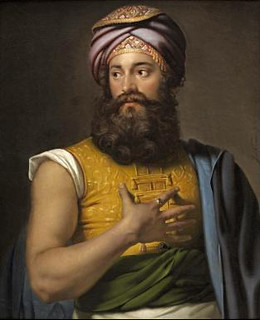 A circus strongman whose plunder of ancient Egypt helped to fill the galleries of British museums is to be reunited with one of his treasures.
A circus strongman whose plunder of ancient Egypt helped to fill the galleries of British museums is to be reunited with one of his treasures.
A portrait of the Great Belzoni, whose strength enabled several colossal pharaonic monuments to be dragged to the banks of the River Nile and onward to Britain during the 19th century has been given to the state.
It is one of more than 40 objects, worth a combined £27 million, being handed to museums as part of a government scheme to encourage cultural donations with the offsetting of taxes.
The portrait of the celebrated performer, who was also an explorer and archaeologist, was painted by the Dutch artist Jan Adam Kruseman and will take pride of place at the Fitzwilliam Museum in Cambridge. It will be displayed with the seven-tonne granite sarcophagus lid of Ramesses III, which the 6ft 7in Giovanni Belzoni prised from the tomb in 1819 and handed to the museum four years later.
It was one of several treasures that Belzoni — who performed circus strongman tricks at Sadler’s Wells before embarking on a career as a true-life Indiana Jones — brought to Britain during the “age of plunder”. Working for Henry Salt, the British consul-general in Egypt, Belzoni secured several objects later sold to the British Museum. These included the colossal 2.7m tall granite head of Ramesses II from the Valley of the Kings which, with the aid of workers and a sledge, he transported to the Nile and on to Bloomsbury.
The Italian, who was the first to rediscover the entrance to the second pyramid of Giza, was later described as the “most notorious tomb-robber Egypt has ever known”. He died in Benin, west Africa in 1823 at the age of 45 after developing dysentery. He had set off to Timbuktu in search of the source of the Niger River.
Daniel Katz, who is donating the portrait of Belzoni, runs an art gallery under his own name in London. He said that he had acquired the portrait because of his “deep love for the study of Egyptology”. He said that Belzoni had been “responsible for bringing some of the most important and beautiful ancient works of art to this country”.
To read the complete article, see:
Strongman of the circus who hauled Egypt’s treasures to UK
(https://www.thetimes.co.uk/article/strongman-of-the-circus-who-hauled-egypts-treasures-touk-90z32phqm)
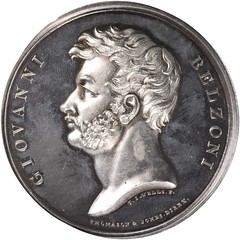
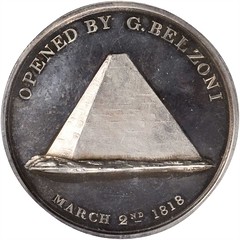
David adds:
There is a numismatic connection too with this medal, issued in silver and copper. Stack's Bowers sold a silver version earlier in 2018. The photos are from their website. I wrote the following in one of my catalogs describing the medals.
Below is the caption that I put under the photo of the medal.
Giovanni Battista Belzoni, Venetian explorer, actor, and engineer. 1778-1823. Medal issued in silver and bronze. (approx. 53mm.). Designed by T. I. Wells after a sketch by William Brockedon; Manufactured by Edward. Thomason in England. Dated 1818 (though struck 1821/1822). GIOVANNI BELZONI, bare head left / OPENED BY G. BELZONI. The pyramid on the reverse of the medal is actually incorrect, and depicts the Third Pyramid of Giza [Khufu] . Belzoni actually discovered the entrance to the Second Pyramid and chiseled his name BELZONI above the entrance. [Khafre] ; MARCH 2ND 1818 in exergue. BHM 969; Eimer 1105. Rare.
This rare medal by a now unknown admirer commemorates the feats of Giovanni Battista Belzoni, Venetian explorer, actor, and engineer. 1778-1823. Ironically, the medal’s designer T.I. Wells did not select the correct Giza pyramid, so the incorrect reverse image is of the third Pyramid of Cheops (Khufu’s pyramid) with the distinctive top roof is slightly caved in making it look “lopped off”, not the Second Pyramid of Khafre that Belzoni actually opened. This medal was created during his lifetime, commissioned by several of his British friends. It is rare. There is an example of this medal in the Petrie Collection at University College, London. There are examples in the British Museum, the Ashomolean, Fitzwilliam and Birmingham museums.
Giovanni Battista Belzoni was born in Padua in 1778, and prior to becoming one of the earliest Egyptologists of the day, was a circus performer in England. He was multi-talented, as he was also a hydraulic engineer, an actor and an artist. A giant at 6 foot, 7 inches tall, he was extremely strong and promoted as the 'Patagonian Sampson' at Sadler's Wells Theatre. Later he styled himself as ‘The Great Belzoni’ all over Europe. His interests in Egyptian travel led him there, where he attempted to promoted improved hydraulic machines to raise he waters of the Nile.
He was eventually drawn to acquiring Egyptian antiquities. In partnership with the British ambassador to Egypt, Henry Salt (1815-1827) he worked as Salt’s agent to remove and ship the massive bust Ramses II (the ‘Young Memnon’) to the British Museum. His biggest discovery was the discovery of an entrance to the Second Pyramid of Giza (known as the Pyramid of Khafre/Chefren), which he was the first to open and explore. He was the first European to visit the oasis of Siwah. He found six royal tombs in the Valley of the Kings, He discovered the ruined city of Berenice (on the Red Sea.) Belzoni was a pioneer Egyptologist, with many major achievements, yet few remember him today. Belzoni died prematurely at the age of 45 while searching for a route to Timbuktu. Considered a rogue, he died unappreciated by most scholars in the new field of archeology to which he contributed much. He was instrumental in the transport of some of the best Egyptian relics in the British Museum, a difficult task , particularly in the early 1800s. There are several good books on his life and achievements, THE GREAT BELZONI, by Stanley Mayes (1959 and 2003), and Belzoni: The Giant Archeologists Love to Hate by Ivor Noel Hume(2011) .
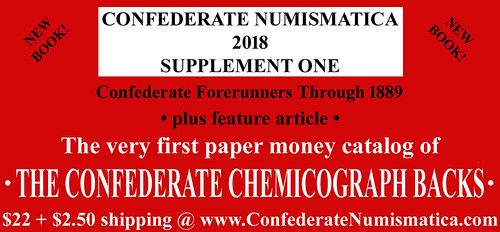
FEYNMAN'S NOBEL PRIZE MEDAL BRINGS $975,000
This didn't make the cut last week, but here's an excerpt from the December 3, 2018 Sotheby's press release with the results of the sale of Richard Feynman's Nobel Prize medal. -Editor
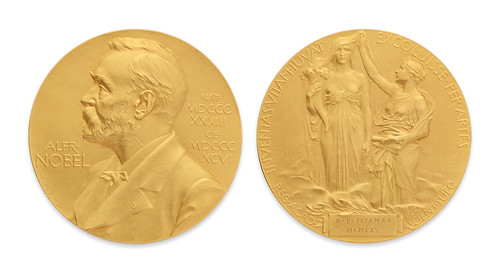
Sotheby’s Geek Week auctions concluded Friday in New York with a total of $7.4 million, featuring sales dedicated to Space Exploration and The History of Science & Technology.
Cassandra Hatton, Vice President & Senior Specialist in Sotheby’s Books & Manuscripts Department commented: “It was so exciting to see such enthusiasm for our first ever ‘Geek Week’ auctions. I am incredibly honored to have been entrusted with the sale of the Nobel Prize, papers, and books of Richard P. Feynman, one of my personal heroes, and I am thrilled with the outstanding results. The depth of bidding and impressive prices achieved are a clear indicator that Feynman’s work and legacy continue to resonate with collectors today, and in particular, the prices achieved for the manuscripts would indicate that Feynman’s scientific work is more precious than gold. It was also especially exciting to become one of only two people, along with Sotheby’s former Vice-Chairman David Redden, to have sold the only known documented samples of the moon available for private ownership.”
Below is a look at some of the highlights that drove these results.
Auction Total: $4.9 Million
Sotheby’s second annual History of Science & Technology auction was led by the Nobel Prize, papers and books of the brilliant, inspiring, and much-beloved theoretical physicist Richard P. Feynman, which were offered across 42 lots. Spanning the full length of his career – from his early days at Los Alamos and Cornell through his final days at the California Institute of Technology (Caltech), and covering topics such as the atom bomb, QED, Nanotechnology and Computing – the remarkable and enlightening collection of papers are the only known archive of Feynman manuscripts to exist outside of the archive at Caltech, where he taught for nearly 4 decades.
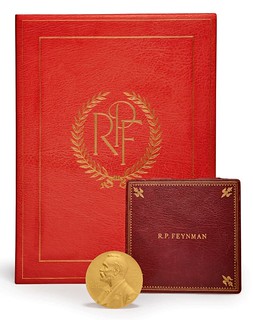 In the year of the centenary of Feynman’s birth, his 1965 Nobel Prize in Physics achieved $975,000. The prize was awarded to Feynman along with fellow physicists Julian
Schwinger and Shin’ichiro Tomonaga, “for their fundamental work in quantum electrodynamics, with deep-ploughing consequences for the physics of elementary particles.” The three
physicists independently developed different ingenious methods to reconcile the electromagnetic field theory of the 19th century with the quantum mechanics theory of the 20th.
Feynman’s method involved his invention of the revolutionary ‘Feynman Diagram’ – innovative pictorial representations that provided a clear visual explanation of every possible
interaction between electrons and photons.
In the year of the centenary of Feynman’s birth, his 1965 Nobel Prize in Physics achieved $975,000. The prize was awarded to Feynman along with fellow physicists Julian
Schwinger and Shin’ichiro Tomonaga, “for their fundamental work in quantum electrodynamics, with deep-ploughing consequences for the physics of elementary particles.” The three
physicists independently developed different ingenious methods to reconcile the electromagnetic field theory of the 19th century with the quantum mechanics theory of the 20th.
Feynman’s method involved his invention of the revolutionary ‘Feynman Diagram’ – innovative pictorial representations that provided a clear visual explanation of every possible
interaction between electrons and photons.
Leading the collection of Feynman manuscripts was a group of papers showing his derivations of the Schrödinger Equation via the Feynman path integral. Illuminating the equivalence of these distinct but complementary formulations of quantum mechanics, the papers fetched $399,000.
Another top lot of the collection was an autographed draft for Feynman’s famous lecture "There's Plenty of Room at the Bottom; An Invitation to Enter a New Field of Physics." Widely credited with sparking the field of Nanotechnology, the draft sold for $387,000. In his address Feynman imagined "that we could arrange atoms one by one, just as we want them," and in this spirit he posed two challenges that would lead to the development of the field of Nanotechnology, offering $1,000 dollars each to whomever could 1) construct a tiny motor, and 2) to whomever could fit the entire Encyclopedia Britannica on the head of a pin.
To read the earlier E-Sylum article, see:
SOTHEBY'S OFFERS FEYNMAN NOBEL PRIZE MEDAL (https://www.coinbooks.org/v21/esylum_v21n37a31.html)
THE BOOK BAZARRE
PRESENTATION MEDAL AUCTION RAISES $2,420
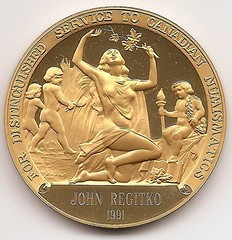 As reported previously, E-Sylum subscriber John Regitko from Canada auctioned off 48 of his numismatic award medals through Geoffrey Bell Auctions. As well, 13 of
his wife’s medals she earned assisting at conventions were also included.
As reported previously, E-Sylum subscriber John Regitko from Canada auctioned off 48 of his numismatic award medals through Geoffrey Bell Auctions. As well, 13 of
his wife’s medals she earned assisting at conventions were also included.
They garnered bids totaling $2,420, plus $484 buyer’s premium).
The highlight of the donation auction consisted of Canada’s highest award for numismatic excellence. It yielded $725 plus $145 buyer’s premium.
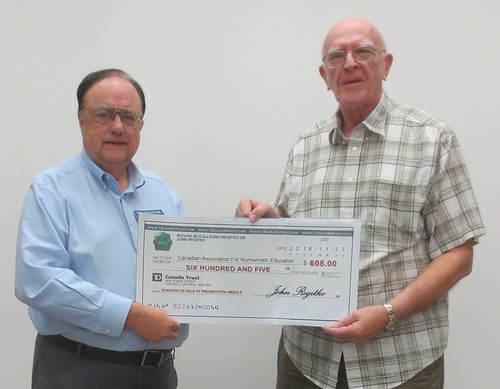
Half of the proceeds have been donated to the registered non-profit organizations that support numismatics in Canada. That includes the Canadian Association for Numismatic Education (CAFNE) which supports the RCNA’s educational programs, and the J. Douglas Ferguson Historical Research Foundation, who supports the publication of collector’s numismatic research. The photo shows CAFNE’s executive secretary/treasurer accepting the cheque from John.
“The other half of the proceeds have been donated to non-profit organizations that my family has had a need of in the past, such as Sick Children’s Hospital, Heart and Stroke Foundation, St. Michael’s Hospital, Canadian Blood Services, Red Cross and the church,” John stated.
He adds: “I was sure I would be criticized for my decision, but I turned the awards into something that will benefit the hobby. I haven’t heard about anyone stating I should not have done it.”
Donating it to the organizations that awarded them was not an option, since not of them have a venue for displaying numismatic material such as the ANA’s Money Museum.
Not only did the principals of the auction house agree to forego all consignor’s commissions, but in a further showing of goodwill, they donated all commissions from the sale to the J. Douglas Ferguson Historical Research Foundation. Geoffrey Bell of the auction company bearing his name is a member of the board as well as a past chairman of the Ferguson Foundation.
Is John happy with the pricing realized? “I had no idea what to expect, because I have not heard of a public auction of the Ferguson Award and other awards. In hindsight, I think that the people that bid the Ferguson medal up to $725 are to be congratulated, keeping in mind that it was gold plated silver and not solid gold. The other awards, including my wife’s medals, also did as well as I hoped they would.”
John has consigned additional awards medals to Geoffrey Bell Auctions on May 2 and 3 being held in conjunction with the Spring 2019 Coin Expo. John and Geoff have again committed to donate the proceeds and bidder’s premiums to the same charitable organizations.
To read the earlier E-Sylum article, see:
REGITKO NUMISMATIC AWARDS MEDALS OFFERED (https://www.coinbooks.org/v21/esylum_v21n36a10.html)
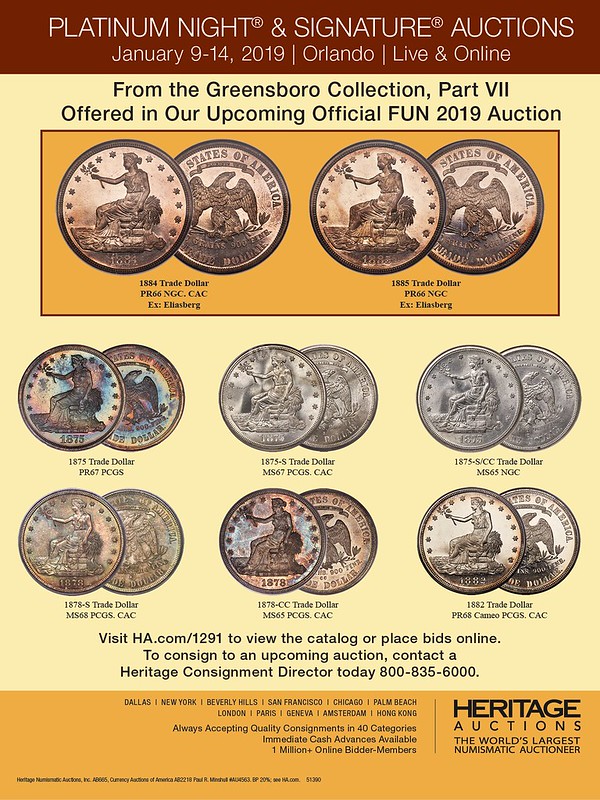
NIGERIAN BANKNOTE COLLECTOR ADETUNJI OMOTOLA
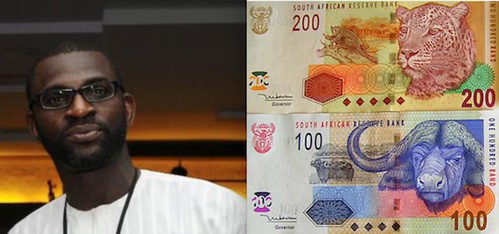
So TheAfricanDream.net out of curiosity recently got curious about our favorite numismatist Adetunji Omotola and his interest in Africa’s over 53 currencies, especially when the Nigerian made us aware that as of January 1, 2013, the Zambian Kwacha (ZMW) was the strongest currency on the continent.
“I have always been fascinated by currencies no matter which countries they come from. We have recently seen increased economic growth in many African countries driven by high commodity prices and China’s massive demand,” an excited Mr. Omotola said to TheAfricanDream.net.
“Some African countries like Ghana, Zambia, Mozambique, and Mauritania have also embarked on re-denomination of their respective currencies. In view of all of these factors and given the need to ensure that one has souvenirs from each African country beyond artifacts, I have decided to begin the collection of various African currencies,” Mr. Omotola explained the reason behind his love for numismatics.
Numismatics is the study or collection of coins, paper currency, and medals.
Many African countries will change their currency’s appearance when a new government takes power (often the new head of state will appear on bank notes), though the notional value remains the same. Also, in many African currencies, there is such rampant inflation that re-valuing must take place ever so often, a classic example being the Zimbabwea.
It is tough to live in one African country and endeavor to collect thirty-one currencies across Africa especially given the high cost of travel around the continent. “The fact that some countries’ currencies are not even of any serious value should be something to bear in mind,” said the numismatist who shed light on some of the downsides of his passion. “Currencies like the Burundian Franc (BIF), the Ugandan Shilling (UGX), the Tanzanian Shilling (TZS), and the Guinea Conakry Franc (GNF) are very weak to major currencies like the USD.” Based on this Adetunji advised that one need not bother collecting them, unless, like his, your simple task is to collect every currency in each denomination in existence.
And the juicy part of our chat with this numismatist — when we asked how many of the 50 plus currencies of Africa he has in his collection. You should have heard him blast a giggle that was a poor attempt to hide laughter borne of excitement. “I am in possession of forty-one notes of 10 different African countries. Most were given to me by a Ghanaian based in Botswana, a Mosotho from Lesotho, A South African who traveled to Zambia and a Ghanaian based in Ghana who handed same over to my Ghanaian friend based in Johannesburg that met her in Accra.”
To read the complete article, see:
Nigerian Numismatist Adetunji Omotola And His Love For Africa’s
Currencies (https://www.modernghana.com/news/900955/nigerian-numismatist-adetunji-omotola-and-his-love-for-afric.html)
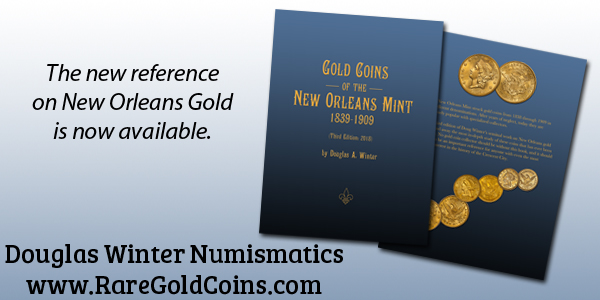
FLUTTERING BANKNOTES SHUT DOWN GERMAN ROAD
Several hundred euros worth of banknotes brought an autobahn to a halt in southern Germany on Wednesday when they rained down on the motorway after a driver apparently forgot his wallet on the car roof.
A driver on the Autobahn 98 in Baden-Württemberg spotted the banknotes swirling around in the air and promptly called the police.
Officers who arrived at the scene shut down two lanes of traffic as a precautionary measure to give them time to gather up the cash. During the search they also found an empty wallet.
Jorg Kiefer, police spokesman in Freiburg, said that they were still waiting for the owner to reclaim his possessions. He added that he wasn’t able to make the exact amount of money public.
To read the complete article, see:
Raining banknotes shut down German motorway
(https://www.telegraph.co.uk/news/2018/12/13/raining-banknotes-shut-german-motorway/)

UKRAINE MENORAH MADE WITH COINS

Ever since I was a child, I can remember seeing an old 19th century Chanukah menorah in my grandmother’s house in the Ukraine. My grandmother was born in 1905 in the small Ukrainian town, Olevsk, and was the youngest daughter of Reb Levi Itzhak Gottlieb and granddaughter of Reb Ishua Gottlieb, renowned tzadikkim from Ludmir. Both had moved from Ludmir to Olevsk were they are buried. Their ohalim are among the few that survived virtually untouched. Every year people from across the globe come to pray at their kevarim.
The old menorah was intricately made with delicately laced silver flowers and had two symmetrical oval medallions on both sides with Hebrew writing on them. A small silver vessel hung from the top corner and was used as the shamash. Some parts, including the silver curved legs, the tiny lids and a beautiful stone in the middle, had been lost over the years.
My mother inherited the menorah, and when we came to the United States in 1995, she brought it with her. She gifted it to me some years ago and we used it every year. However, with each passing year, it was becoming more fragile, so we just kept it on display.
Over the last two years, I became more interested in our family history and looked to confirm some of the amazing stories I have heard about our ancestors. I hired a researcher in the Ukraine and was able to trace back 10 generations to Reb Shlomo HaLevi Gottlieb from Karlin and his son Reb Moshe. We found that Reb Shlomo had married Chaya Sara Twersky, the daughter of Rav Aharon Twersky of Chernobyl.

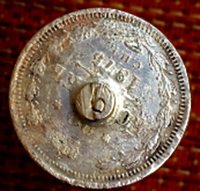
It seems that the oval medallions on the side contained information about Levi Itzhak. It has his name, the word shlita and the letters “ב’ה’ה’ר י’א” indicating that he was the son of a rebbe. There was also an “I,” which we assume was for his son Ishua Gottlieb, and the letter “A” the meaning of which we could not figure out. The left lower line contained Hebrew letters indicating a blessing for his righteous memory.
I could not believe that the evidence that my great-grandparents were renowned rabbis, and their names, was right in front of me all my life. I was happy, and I thought that I had figured out everything about our Chanukah menorah.
A few months later, I decided to polish the menorah for the High Holidays. I was careful, but as I rinsed it, I saw that one of the candleholders came loose and had fallen off. My heart sunk from the thought that I had destroyed the memory of generations. I started to make plans to take it for repairs, when, under close inspection I noticed that the candleholder had a tiny screw at the bottom. I piled up several pairs of magnifying reading glasses and realized that the bottom of the screw had a number, as did the base of the menorah. While hot water had melted the years of oil and candles that had glued it all together, I saw the candleholder was unscrewed, but it was not broken. To my amazement, every candleholder was numbered from 1 to 8, and the base was numbered as well – yet they weren’t assembled in the proper order.
One by one, I unscrewed each candleholder and scrubbed them well. It turns out that at the base of each candle holder was a silver coin.
We photographed and recorded each one, then put it back together in the exact same order we found it in. The coins were from 3 countries – Russia, Austria-Hungary and Romania. The oldest coin was from 1859, and the newest from 1893.
To read the complete article, see:
A Family Treasure
(http://www.jewishpress.com/sections/features/a-family-treasure/2018/12/10/)
THE CHRISTMAS STORY ON NOTGELD
Paper Money Messages author Jeffrey Wing submitted this holiday item. Thank you. -Editor
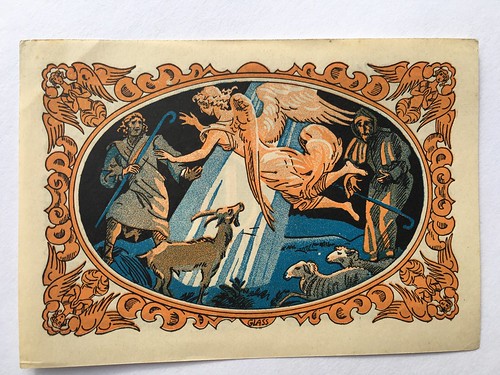
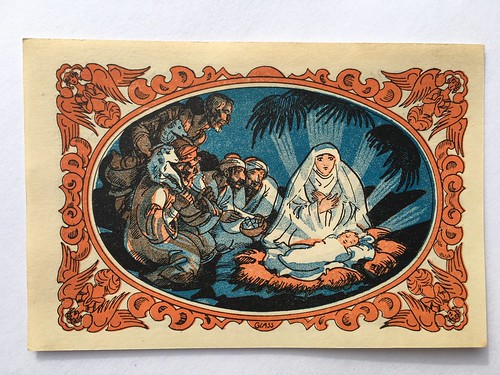
As discussed in Paper Money Messages (Vol 2), emergency money was produced in Germany in 1921 during the period of hyper inflation. Often this money represented the culture of the community. The town of Kahla produced a set of notgeld that describes the Christmas story.
"When the angels had left them and gone into heaven, the shepherds said to one another, "Let's go to Bethlehem and see this thing that has happened, which the Lord has told us about. "So they hurried off and found Mary and Joseph, and the baby, who was lying in the manger. (Luke 2:15-16).
My hope is that the holiday season does not become so hectic that we lose sight of the reason for the season.


